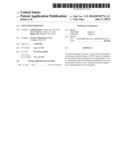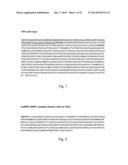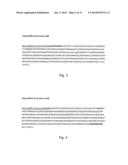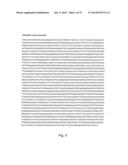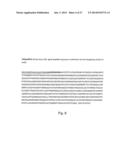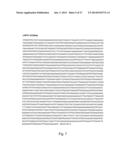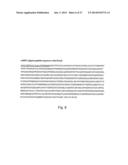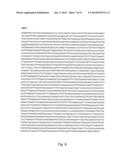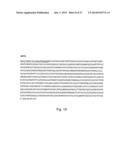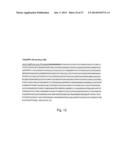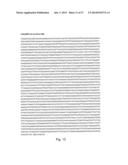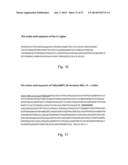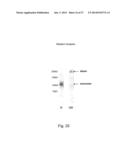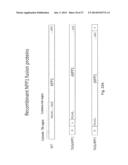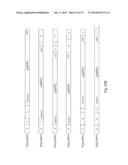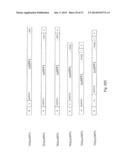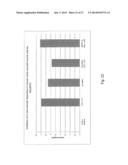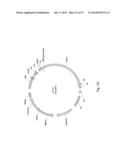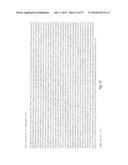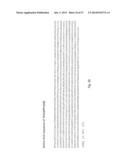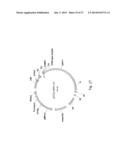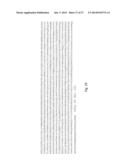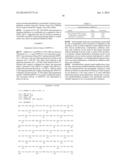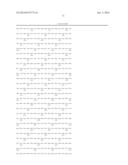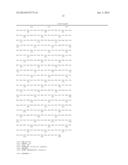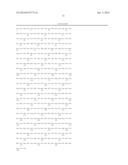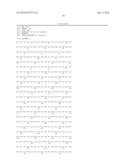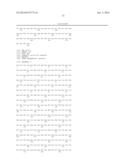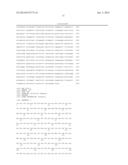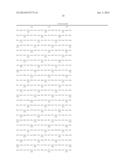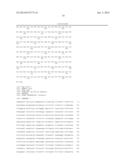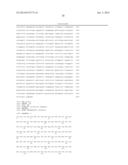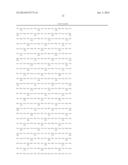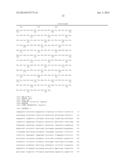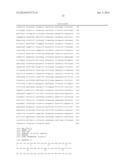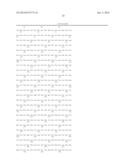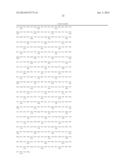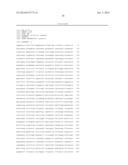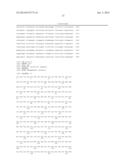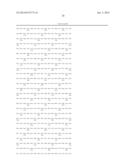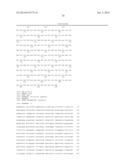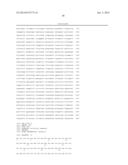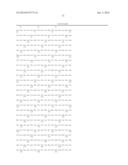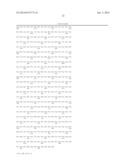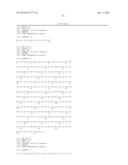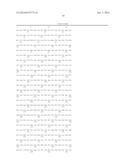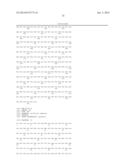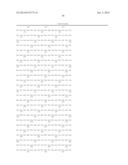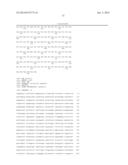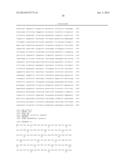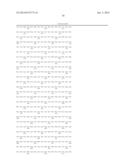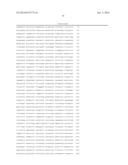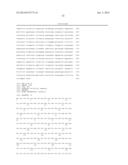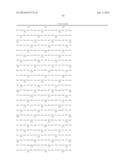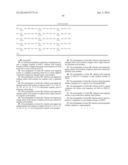Patent application title: NPP1 FUSION PROTEINS
Inventors:
Anthony Quinn (Gloucester, MA, US)
Alex J. Harvey (Athens, GA, US)
Zhinan Xia (Wellesley, MA, US)
Assignees:
Synageva Biopharma Corp.
IPC8 Class: AC12N996FI
USPC Class:
435188
Class name: Chemistry: molecular biology and microbiology enzyme (e.g., ligases (6. ), etc.), proenzyme; compositions thereof; process for preparing, activating, inhibiting, separating, or purifying enzymes stablizing an enzyme by forming a mixture, an adduct or a composition, or formation of an adduct or enzyme conjugate
Publication date: 2014-06-05
Patent application number: 20140154774
Abstract:
The present invention provides a novel fusion polypeptide containing a
catalytic domain of NPP1 fused to a targeting moiety, nucleic acids
encoding the fusion polypeptide, a vector containing the nucleic acid
integrated thereinto, a host cell transformed with the vector and
pharmaceutical compositions comprising the fusion polypeptide.Claims:
1-38. (canceled)
39. An isolated polypeptide comprising a targeting moiety and a catalytic domain of NPP1, wherein said catalytic domain of NPP1 comprises the amino acid sequence set forth from P99 to D925 of SEQ ID NO:1.
40. The polypeptide of claim 39, wherein said targeting moiety is a peptide comprising about five to about eighteen consecutive negatively charged amino acid residues.
41. The polypeptide of claim 39, wherein said negatively charged amino acid residues are aspartic acid or glutamic acid.
42. The polypeptide of claim 41, wherein said negatively charged amino acid residues comprise about 7, 8, 9, 10, 11, 12, 13, 14, 15, 16, 17 or 18 consecutive aspartic acid or glutamic acid residues.
43. The polypeptide of claim 42, wherein said negatively charged amino acid residues comprise about eight consecutive aspartic acid residues.
44. The polypeptide of claim 42, wherein said negatively charge amino acid residues comprises about ten consecutive aspartic acid residues.
45. The polypeptide of claim 41, wherein said negatively charged amino acid residues comprise about 8, 9, 10, 11, 12, 13, 14, 15, 16, 17, or 18 consecutive aspartic acid residues.
46. The polypeptide of claim 45, wherein said negatively charged amino acid residues comprise about eight consecutive glutamic acid residues.
47. The polypeptide of claim 45, wherein said negatively charge amino acid residues comprises about ten consecutive glutamic acid residues.
48. The polypeptide of claim 39, wherein said targeting moiety is fused to C-terminus of said catalytic domain of NPP1.
49. The polypeptide of claim 42, wherein said polypeptide further comprises an Fc region of an immunoglobulin.
50. The polypeptide of claim 49, wherein said Fc region comprises the amino acid sequence set forth in SEQ ID NO:16.
51. The polypeptide of claim 50, wherein said targeting moiety is ten consecutive aspartic acid residues.
52. The polypeptide of claim 49, wherein said Fc region is fused to C-terminus of said catalytic domain of NPP1.
53. The polypeptide of claim 39, wherein said polypeptide further comprises a signal peptide.
Description:
RELATED APPLICATIONS
[0001] This application claims the benefit of PCT/US2011/028233, filed Mar. 11, 2011, which claims the benefit of U.S. Provisional Application No. 61/340,066, filed on Mar. 12, 2010. The entire teachings of the above application are incorporated herein by reference.
BACKGROUND OF THE INVENTION
[0002] Ectonucleotide pyrophosphatase/phosphodiesterase 1 (NPP1/ENPP1/PC-1) is a type II transmembrane glycoprotein that forms a homodimer. The protein cleaves a variety of substrates, including phosphodiester bonds of nucleotides and nucleotide sugars and pyrophosphate bonds of nucleotides and nucleotide sugars. NPP1 protein functions to hydrolyze nucleoside 5' triphosphtase to either corresponding monophosphates and also hydrolyzes diadenosine polyphosphates. Mutations in the NPP1 gene have been associated with idiopathic infantile arterial calcification (IIAC), insulin resistance, hypophosphatemic rickets, and ossification of the posterior longitudinal ligament of the spine.
[0003] IIAC, a rare autosomal recessive and nearly always fatal disorder, is characterized by calcification of the internal elastic lamina of muscular arteries and stenosis due to myointimal proliferation. There are more than 160 cases of IIAC that have been reported world-wide. The symptoms of the disease most often appear by early infancy, and the disease is lethal by 6 months of age, generally because of ischemic cardiomyopathy, and other complications of obstructive arteriopathy including renal artery stenosis. In more than a dozen reported cases of IIAC, periarticular calcifications of large joints also developed in infancy. Rutsch et al. (2003) reported that mutations in ENPP1 are associated with IIAC characterized by the spontaneous periarticular and aortic calcifications in early life and systemic lowering of nucleotide pyrophosphatase/phosphodiesterase activity in the affected individuals.
[0004] Although defects in the NPP1 protein have been implicated in such serious disease as IIAC, there is no treatment available in the art for those who are affected by the disease. Therefore, a dire need exists for an effective and safe composition, formulation and medicament for the treatment of IIAC, insulin resistance, hypophosphatemic rickets, and ossification of the posterior longitudinal ligament of the spine.
SUMMARY OF THE INVENTION
[0005] The present invention includes fusion proteins of truncated domains of NPP1 (i.e., an NPP1 component) fused to a targeting moiety. The targeting moiety functions to enhance the efficiency in targeting the NPP1 fusion protein to a site clinical or biological importance (e.g., site of calcification in a subject that needs lowering of calcification). Without wishing to limit the invention to any particular theory or mechanism of operation it is believed that the NPP1 component function to inhibit calcification by enhancing the formation of pyrophosphate (PPi) and/or by cleaving pyrophosphate to produce soluble phosphate (Pi) and/or by increasing the availability of adenosine monophosphate (AMP) and/or adenosine. It is contemplated that the targeting moiety can be attached to the N-terminus and/or the C-terminus of the NPP1 component at any useful position. Additionally, the NPP1 fusion protein disclosed herein can also include one or more of Fc fragment, PEG, polypeptide linker or other additional polypeptides to enhance the enzymatic activity, stability or targeting.
[0006] The fusion proteins of the invention can be used to treat a wide variety of conditions in a subject. Any condition that can be beneficially treated by the administering of a fusion protein of the invention is included within the scope of the invention. For example, treatment of conditions that can be improved by reducing and/or eliminating one or more calcification structures and/or preventing calcification structures from forming in a subject such as a mammal, for example, a human patient is within the scope of the invention. Conditions such as arterial blockage are contemplated for treatment by employing fusion proteins of the invention. In one particularly useful embodiment, the condition to be treated is generalized arterial calcification of infancy also referred to as idiopathic arterial calcification of infancy and arterial media calcification of infancy. Conditions such as insulin resistance, hypophosphatemic rickets, and ossification of the posterior longitudinal ligament of the spine are also contemplated for treatment.
[0007] Fusion proteins of the invention can be produced in any useful protein expression system including, without limitation, cell culture (e.g., CHO cells, COS cells, HEK203), bacteria such as Escherichia coli (E. coli) and transgenic animals, including, but no limited to, mammals and avians (e.g., chickens, quail, duck and turkey).
[0008] The manufacture of pharmaceutical compositions (or pharmaceutical formulations) is well known in the art and such pharmaceutical compositions are contemplated for use in accordance with fusion proteins of the invention.
[0009] Generally, the dosage of fusion protein administered to a subject will vary depending upon known factors such as age, health and weight of the recipient, type of concurrent treatment, frequency of treatment, and the like. Usually, a dosage of active ingredient (i.e., fusion protein) can be between about 0.0001 and about 50 milligrams per kilogram of body weight. Precise dosage, frequency of administration and time span of treatment can be determined by a physician skilled in the art of administration of therapeutic proteins.
BRIEF DESCRIPTION OF THE DRAWINGS
[0010] FIG. 1 illustrates the amino acid sequence of wild-type NPP1 protein. The cytosolic and transmembrane regions are underlined. The potential N-glycosylation sites are in bold. PSCAKE in italics is the start of soluble NPP1 which includes the cysteine rich region.
[0011] FIG. 2 illustrates the amino acid sequence of the catalytic domain(s) of NPP1 protein having no target moiety attached ("sssNPP1").
[0012] FIG. 3 illustrates the amino acid sequence of TAGsssNPP1. The targeting moiety of eight consecutive aspartic acid residues is fused to the N-terminus of the sssNPP1. The signal peptide is underlined, and the targeting moiety is indicated in bold.
[0013] FIG. 4 illustrates the amino acid sequence of TAGsssNPP1 that contains the targeting moiety of ten consecutive aspartic acid residues fused to the C-terminus of the sssNPP1. The signal peptide is underlined, and the targeting moiety is indicated in bold.
[0014] FIG. 5 illustrates the nucleic acid sequence of TAGssNPP1 fusion protein. The targeting moiety of eight consecutive aspartic acid residues is fused to the N-terminus of the ssNPP1.
[0015] FIG. 6 illustrates the amino acid sequence of TAGssNPP1 fusion protein. The targeting moiety of eight consecutive aspartic acid residues is fused to the N-terminus of the ssNPP1. The signal peptide is underlined, and the targeting moiety is indicated in bold.
[0016] FIG. 7 illustrates the nucleic acid sequence of ssNPP1.
[0017] FIG. 8 illustrates the amino acid sequence of ssNPP1. The signal peptide is underlined.
[0018] FIG. 9 illustrates the nucleic acid sequence of sNPP1.
[0019] FIG. 10 illustrates the amino acid sequence of sNPP1. The signal peptide is underlined.
[0020] FIG. 11 illustrates the nucleic acid sequence of TAGsNPP1. The targeting moiety of eight consecutive aspartic acid residues is fused to the N-terminus of the sNPP1.
[0021] FIG. 12 illustrates the amino acid sequence of TAGsNPP1. The targeting moiety of eight consecutive aspartic acid residues is fused to the N-terminus of the ssNPP1. The signal peptide is underlined, and the targeting moiety is indicated in bold.
[0022] FIG. 13 illustrates the nucleic acid sequence of TAGsNPP1. The targeting moiety of eight consecutive aspartic acid residues is fused to the C-terminus of the sNPP1.
[0023] FIG. 14 illustrates the amino acid sequence of TAGsNPP1. The targeting moiety of eight consecutive aspartic acid residues is fused to the N-terminus of the sNPP1. The signal peptide is underlined, and the targeting moiety is indicated in bold.
[0024] FIG. 15 illustrates the amino acid sequence of a linker peptide.
[0025] FIG. 16 illustrates the amino acid sequence of an immunoglobulin Fc segment.
[0026] FIG. 17 illustrates the amino acid sequence of TAGsssNPP1 which contains the targeting moiety of eight consecutive aspartic acid residues fused to the N-terminus of the sssNPP1 via a peptide linker. The Fe segment is fused to N-terminus of the target moiety. The signal peptide is underlined and the targeting moiety is indicated in bold. The peptide linker is in italics.
[0027] FIG. 18 illustrates the amino acid sequence of TAGsssNPP1 which contains the targeting moiety of eight consecutive aspartic acid residues fused to the C-terminus of the sssNPP1 via a peptide linker. The Fc segment is fused to N-terminus of the sssNPP1. The signal peptide is underlined and the targeting moiety is indicated in bold. The peptide linker is in italics.
[0028] FIG. 19 is a schematic representation of an expression vector (i.e., pTT22) containing a TAGsNPP1 construct. The targeting moiety of eight consecutive aspartic acid residues fused to the C-terminus of the sNPP1.
[0029] FIG. 20 illustrates Western blot analysis of TAGsNPP1. Reducing condition; NR, non-reducing condition.
[0030] FIG. 21 demonstrates the enzymatic activity of TAGsNPP1 produced and isolated from HEK293 cells.
[0031] FIGS. 22A-22C illustrate schematics of TAGNPP1 fusion protein constructs described herein.
[0032] FIG. 23 demonstrates calicification levels of human aortic smooth muscle cells treated with soluble sNPP1 (WT), TAGsNPP1 (D8 fused to sNPP1 C-terminus), and sNPP1-Fc.
[0033] FIG. 24 depicts a schematic representation of an expression vector (i.e., pTT22) containing a TAGsNPP1 construct. The targeting moiety of eight consecutive aspartic acid residues (D8) fused to the C-terminus of the sNPP1.
[0034] FIG. 25 depicts the nucleic acid sequence of a TAGsNPP1 fusion protein.
[0035] FIG. 26 depicts the amino acid sequence of a TAGsNPP1 fusion protein.
[0036] FIG. 27 depicts a schematic representation of an expression vector (i.e., pTT22) containing a sNPP1-Fc fusion construct.
[0037] FIG. 28 depicts the nucleic acid sequence of a sNPP1-Fc fusion protein.
[0038] FIG. 29 depicts the amino acid sequence of a sNPP1-Fc fusion protein.
DETAILED DESCRIPTION OF THE INVENTION
[0039] The present invention provides novel human NPP1 fusion proteins that are soluble and contain truncated and biologically active domain(s) of NPP1 (i.e., NPP1 components that contain at least one extracellular catalytic domain of naturally occurring NPP1 for the pyrophosphatase and/or phosphodiesterase activity) and one or more targeting moieties (i.e., "TAG"). The NPP1 fusion proteins of the present invention comprise at least the NPP1 domain essential to carry out the pyrophosphatase and/or phosphodiesterase activity. Accordingly, the invention features isolated fusion proteins comprising the amino acid residues A205 through L591 of SEQ ID NO:1 fused to one or more targeting moieties. The targeting moiety can be recombinantly fused or chemically bonded (e.g., covalent bond, ionic bond, hydrophobic bond and Van der Waals force) to the NPP1 component by methods well known in the art and direct the NPP1 component to a certain target site where the attached NPP1 component will have a desirable effect (e.g., catalysis of a reaction such as solubilizing a substrate such as PPi or preventing the formation of a substrate such as PPi) in a subject to which the fusion protein of the present invention is administered.
TAGNPP1s
[0040] All NPP1 fusion proteins ("TAGNPP1s") of the present invention have the N-terminal cytosolic and the transmembrane domains of the naturally occurring human NPP1 removed. Optionally, TAGNPP1s fusion proteins of the present invention can also contain C-terminal truncation of wild-type NPP1 in various lengths. The amino acid sequence of full-length wild-type NPP1 is set forth in SEQ ID NO: 1.
[0041] In one embodiment, the fusion protein contains a polypeptide comprising the amino acid residues A205 through L591 of SEQ ID NO:1 ("sssNPP1") fused a TAG on either the N- or C-terminus of the polypeptide ("TAGsssNPP1"). In one embodiment, the fusion protein comprises a polypeptide comprising the amino acid residues A205 through D925 of SEQ ID NO:1 ("ssNPP1") fused to a TAG on either the N- or C-terminus ("TAGssNPP1"). In one embodiment, the fusion protein comprises a polypeptide comprising the amino acid residues P99 through D925 of SEQ ID NO:1 ("sNPP1") fused to a TAG on either the N- or C-terminus of the polypeptide ("TAGsNPP1"). Also contemplated is any consecutive fragment of sNPP1 that comprises at least the amino acid resides A205 through L591 of SEQ ID NO:1 and the polypeptide fragment is fused to a TAG on either the N- or C-terminus.
[0042] When expressed in a cell culture or transgenic animal, the TAGNPP1 fusion proteins can further comprise a signal peptide (or leader sequence) at its N-terminus. The signal peptide co-translationally or post-translationally directs transport of the TAGNPP1 fusion proteins through the subcellular organelles of the cell expressing the TAGNPP1 fusion proteins and, thereby determining the post-translational modification of the TAGNPP1 fusion proteins. It is to be understood that because the signal peptide is cleaved at the co-translational or post-translational stage of the fusion protein, the TAGNNP 1 fusion proteins are generally devoid of the signal peptide when once secreted and isolated. Accordingly, in the embodiments that are directed to the nucleic acid sequences encoding the TAGNPP1 fusion proteins are described, the leader sequences are also contemplated as used in the present invention. For example, the nucleotide sequence set forth in SEQ ID NO:2 contains an example of the leader sequence for TAGNNP1 at its 5' end.
[0043] Each of the fusion proteins disclosed herein is contemplated with one or more targeting moieties ("TAG"). The TAG component according to the present invention comprises four or more negatively charged amino acids such as aspartic acid and glutamic acid. The TAG component can be a stretch of negatively charged amino acid residues, for example, aspartic acids and/or glutamic acids that are between about 4 and about 20 amino acid residues in length. The TAG can be fused to either the N- or C-terminus of the NPP1 component. The TAG can be also fused to both N- and C-termini of the NPP1 component. Accordingly, the amino acid sequence of the TAGsNPP1 fusion protein, for example, includes PSCAKE through the C-terminus end of the NPP1 component and one or more targeting moieties (e.g., polyglutamic acid tag or polyaspartic acid tag) at the N- and/or C-terminus end of the NPP1 component. The fusion protein comprising the NPP1 component having the TAG fused to the C-terminus is a particularly useful embodiment. In one very specific embodiment, TAG having a stretch of eight aspartic acids is employed as can be seen in the exemplary sequences for TAGsNPP1 and TAGssNPP1 in Figures, though any useful number of negatively charged amino acid residues (e.g., 4, 5, 6, 7, 9, 10, 11, 12, 13, 14, 15, 16, 17, or 18) can be used in accordance with the invention. The TAG component is indicated as "A" in Figures.
[0044] The invention also encompasses polynucleotides which encode various TAGNPP1 fusion proteins described herein. Accordingly, any nucleic acid sequence which encodes the amino acid sequence of any TAGNPP1 fusion protein can be used to generate recombinant molecules which express the corresponding TAGNPP1 fusion protein. In a particular embodiment, the invention encompasses the polynucleotide comprising the nucleic acid sequence of SEQ ID NO:2 as shown in FIG. 2.
[0045] Within certain specific embodiments, the fusion protein comprises multiple polypeptides as described herein, or that comprises at least one polypeptide as described herein and an unrelated sequence. Certain preferred polypeptide can, for example, assist in dimerization and stability or minimize aggregation of the fusion proteins. For example, the additional polypeptide can be the Fc region of the immunoglobulin G1 to increase stability in serum. The use of the Fc segment is well known in the art and described in U.S. Pat. No. 7,902,151; and U.S. Pat. No. 7,858,297, the entire teachings of which are incorporated herein by reference in their entirety. The cysteine rich region of wild-type NPP1 (i.e., PSCAKE through NEPQCP; the amino acid sequence from P99 to P204 of SEQ ID NO:1) can be employed to facilitates dimerization of the TAGNPP1 fusion proteins.
[0046] In another embodiment, the polyethylene glycol (PEG) can be conjugated to the TAGNPP1 fusion proteins. Other polypeptides may be selected so as to minimize aggregation and immunogenicity, to increase the solubility of the protein, or to enable the protein to be targeted to desired sites of clinical or biological importance.
[0047] TAGNPP1 can be also fused or conjugated to an appropriate polypeptide linker or other sequence for ease of identification, synthesis, or purification of the fusion protein, or to better preserve the native structure of the NPP1 component which can enhance the activity and targeting of the TAGNPP1. Specifically, a peptide linker sequence can be employed to separate the first and the second polypeptide components by a distance sufficient to ensure that each polypeptide folds into its secondary and tertiary structures. Such a peptide linker sequence is incorporated into the fusion protein between the NPP1 component and the TAG component using standard techniques well known in the art. Suitable peptide linker sequences may be chosen based on their ability to adopt a flexible extended conformation and their inability to adopt a secondary structure that could interact with functional portion on the NPP1, TAG or other secondary polypeptides described herein (e.g., Fc). Preferred peptide linker sequences contain Gly, His, Asn and Ser residues. The useful peptide linkers include, without limitation, poly-Gly, poly-His, poly-Asn, or poly-Ser. Other near neutral amino acids, such as Thr and Ala can be also used in the linker sequence. Amino acid sequences which can be usefully employed as linkers include those disclosed in Maratea et al., Gene 40:39-46, 1985; Murphy et al., Proc. Natl. Acad. Sci. USA 83:8258-8262, 1986; U.S. Pat. No. 4,935,233 and U.S. Pat. No. 4,751,180. The linker sequence may be from 1 to about 20 amino acid residues in length. Preferably, the polypeptide linker is between about 8 and about 12 amino acids in length. In a preferred embodiment, the peptide linker used in the invention is GGGGSGGGGS (SEQ ID NO:15), although any functional combination of Gly, Ser, His, or Asn can be employed.
[0048] Fusion proteins can also comprise a TAGNPP1 of the present invention together with an unrelated polypeptide. Preferably the unrelated polypeptide is capable of enhancing the targeting of the fusion protein to the site of clinical or biological importance (e.g., site of calcification). For example, peptides that have high affinity to the bone are described in U.S. Pat. No. 7,323,542, the entire teachings of which are incorporated herein by reference.
[0049] TAGNPP1 can be prepared using standard methods, including recombinant techniques or chemical conjugation well known in the art. Techniques useful for isolating and characterizing the nucleic acids and proteins of the present invention are well known to those of skill in the art and standard molecular biology and biochemical manuals can be consulted to select suitable protocols for use without undue experimentation. See, for example, Sambrook et al, 1989, "Molecular Cloning: A Laboratory Manual," 2nd ed., Cold Spring Harbor, the content of which is herein incorporated by reference in its entirety. Briefly, DNA sequences encoding the polypeptide components can be assembled separately, and ligated into an appropriate expression vector. For example, the 3' end of the DNA sequence encoding the NPP1 component is ligated, with or without a peptide linker, to the 5' end of a DNA sequence encoding the second polypeptide component such as TAG PEG, or Fc so that the reading frames of the sequences are in phase. This permits translation into a single fusion protein that retains the biological activity of both component polypeptides. The ligated DNA sequences are operably linked to suitable transcriptional or translational regulatory elements including a promoter. The regulatory elements responsible for expression of DNA are located only 5' to the DNA sequence encoding the first polypeptide such as the leader sequence encoding a signal peptide. Similarly, stop codons required to end translation and transcription termination signals are only present 3' to the DNA sequence encoding the second polypeptide.
[0050] The invention also encompasses TAGNPP1 variants. A preferred TAGNPP1 variant is one having 80%, 85%, 90%, 95% and more preferably 96% amino acid sequence identity to the amino acid sequence A205 through L591 of SEQ ID NO:1. A most preferred TAGNPP1 variant is one having at least 97% amino acid sequence identity to amino acid sequence A205 through L591 of SEQ ID NO:1.
[0051] The invention also relates to a polynucleotide sequence comprising the complement of SEQ ID NO:2 or variants thereof. In addition, the present invention also features polynucleotide sequences which hybridize under stringent conditions to SEQ ID NO:2 and whose the antisense sequence is 85%, 90%, 95%, 97%, 98%, or 99% identical to SEQ ID NO:2. Hybridization conditions are based on the melting temperature (Tm) of the nucleic acid binding complex or probe, as taught in Wahl, G. M. and S. L. Berger (1987; Methods Enzymol. 152:399-407) and Kimmel, A. R. (1987; Methods Enzymol. 152:507-511), and can be used at a defined stringency.
[0052] The invention additionally contemplates nucleic acid sequences encoding polypeptides, oligonucleotides, peptide nucleic acids (PNA), fragments, portions or antisense molecules thereof.
[0053] Although nucleotide sequences which encode TAGNPP1 and its variants are preferably capable of hybridizing to the nucleotide sequence of the TAGNPP1 under appropriately selected conditions of stringency, it can be advantageous to produce nucleotide sequences encoding TAGNPP1 or its derivatives possessing a substantially different codon usage. Codons can be selected to increase the rate at which expression of the peptide occurs in a particular prokaryotic or eukaryotic host in accordance with the frequency with which particular codons are utilized by the host. Other reasons for substantially altering the nucleotide sequence encoding TAGNPP1 and its derivatives without altering the encoded amino acid sequences include the production of RNA transcripts having more desirable properties, such as a greater half-life.
[0054] Altered nucleic acid sequences encoding TAGNPP1 which are encompassed by the invention include deletions, insertions, or substitutions of different nucleotides resulting in a polynucleotide that encodes the same or a functionally equivalent of TAGNPP1. The encoded protein can also contain deletions, insertions, or substitutions of amino acid residues which produce a silent change and result in a functionally equivalent TAGNPP1. Deliberate amino acid substitutions can be made on the basis of similarity in polarity, charge, solubility, hydrophobicity, hydrophilicity, and/or the amphipathic nature of the residues as long as the biological activity of TAGNPP1 is retained. For example, positively charged amino acid residues include Lys and Arg; negatively charged amino acid residues include Asp and Glu; and amino acids with uncharged polar head groups having similar hydrophilicity can include Leu, Ile, and Val; Gly and Ala; Asp and Gln; Ser and Thr; Phe and Tyr.
[0055] Expression Vector
[0056] Methods which are well known to those skilled in the art can be used to construct expression vectors containing sequences encoding TAGNPP1 and appropriate transcriptional and translational control elements. These methods include in vitro recombinant DNA techniques, synthetic techniques, and in vivo genetic recombination. Such techniques are described, for example, in Sambrook, J. et al. (1989) Molecular Cloning, A Laboratory Manual, Cold Spring Harbor Press, Plainview, N.Y., and Ausubel, F. M. et al. (1989) Current Protocols in Molecular Biology, John Wiley & Sons, New York, N.Y., the teachings of which are incorporated herein by reference in its entirety.
[0057] A variety of expression vector/host systems can be utilized to contain and express sequences encoding TAGNPP1. These include, but are not limited to, microorganisms such as bacteria transformed with recombinant bacteriophage, plasmid, or cosmid DNA expression vectors; yeast transformed with yeast expression vectors; insect cell systems infected with virus expression vectors (e.g., baculovirus) or with bacterial expression vectors (e.g., Ti or pBR322 plasmids); or animal cell systems (e.g., pTT22 vector).
[0058] The control elements or regulatory sequences can includes those non-translated regions of the vector-enhancers, promoters, 5' and 3' untranslated regions-which interact with host cellular proteins to carry out transcription and translation. Such elements can vary in their strength and specificity. Depending on the vector system and host utilized, any number of suitable transcription and translation elements, including, tissue-specific, constitutive and inducible promoters, can be used. For example, when cloning in bacterial systems, inducible promoters such as the hybrid lacZ promoter of the Bluescript® phagemid (Stratagene, LaJolla, Calif.) or pSport1® plasmid (Gibco BRL) and the like can be used. In mammalian cell systems, promoters from mammalian genes or from mammalian viruses are preferred. If it is necessary to generate a cell line that contains multiple copies of the sequence encoding TAGNPP1, vectors based on SV40 or EBV can be used with an appropriate selectable marker. When an avian expression system is used, suitable vectors for expression various TAGNPP1 constructs are described in U.S. Pat. No. 6,730,822; U.S. Pat. No. 6,825,396; U.S. Pat. No. 6,875,588; U.S. Pat. No. 7,294,507; U.S. Pat. No. 7,521,591; U.S. Pat. No. 7,534,929; and U.S. patent application Ser. No. 11/376,023, the entire teachings of which are incorporated herein by reference in their entirety. Briefly, when an avian expression system is employed to express TAGNPP1, suitable oviduct-specific promoters, for example, and without limitation, ovomucoid promoters, ovalbumin promoters, lysozyme promoters, conalbumin promoters, ovomucin promoters, ovotransferrin promoters and functional portions of each of these promoters are contemplated. Suitable non-specific promoters can include, for example and without limitation, cytomegalovirus (CMV) promoters, MDOT promoters and rous-sarcoma virus (RSV) promoters, murine leukemia virus (MLV) promoters, mouse mammary tumor virus (MMTV) promoters and SV40 promoters and functional portions of each of these promoters. Non-limiting examples of other promoters which can be useful in the present invention include, without limitation, Pol III promoters (for example, type 1, type 2 and type 3 Pol III promoters) such as H1 promoters, U6 promoters, tRNA promoters, RNase MPR promoters and functional portions of each of these promoters. Typically, functional terminator sequences are selected for use in the present invention in accordance with the promoter that is employed.
[0059] Host Cells
[0060] The present invention includes the production of soluble TAGNPP1 in a transgenic avian (e.g., transgenic chicken) system as is well known in the art, for example, in U.S. Pat. No. 7,534,929, the disclosure of which is incorporated in its entirety herein by reference. Production in the avian system (e.g., in the avian oviduct) of an NPP1 component with or without to a targeting moiety (e.g., ssNPP1, sNPP1, TAGsNPP1 and TAGssNPP1) is within the scope of the invention. Furthermore, TAGNPP1 produced in any useful protein expression system including, without limitation, transgenic avians, transgenic mammal, cell culture (e.g., CHO cells, HEK293 cells, and COS cells), bacteria such as E. coli, transgenic animals such as mammals and avians (e.g., chickens, quail, duck and turkey) and in plant systems including duck weed, is contemplated herein.
[0061] A host cell strain can be chosen for its ability to modulate the expression of the inserted sequences or to process the expressed TAGNPP1s in the desired fashion. Such modifications of the polypeptide of TAGNNP 1 include, without limitation, acetylation, carboxylation, sialylation, glycosylation, phosphorylation, lipidation, and acylation. Different host cells such as CHO, COS, HeLa, MDCK, HEK293, and W138, which have specific cellular machinery and characteristic mechanisms for such post-translational activities, can be chosen to ensure the correct modification and processing of the fusion protein of the present invention. Avian tumor cell line is also contemplated as a host cell for expressing the polypeptide of the present invention. Examples of useful avian cell lines (e.g., an avian oviduct tumor cell line) which can be employed in the present invention are described in U.S. Pat. Publication No. 2009/0253176, the entire teachings of which are incorporated herein by reference.
[0062] Production of TAGNPP1
[0063] TAGNPP1 can be produced using any of a variety of well-known techniques. TAGNPP1 encoded by DNA sequences as described above can be readily prepared from the DNA sequences using any of a variety of expression vectors described herein or well known to those of ordinary skill in the art. Expression can be achieved in any appropriate host cell that has been transformed or transfected with an expression vector containing a DNA molecule that encodes a recombinant polypeptide of the present invention. Supernatants from suitable host/vector systems which secrete recombinant fusion protein or polypeptide into culture media can be first concentrated using a commercially available filter. Following concentration, the concentrate can be applied to a suitable purification matrix such as an affinity matrix or an ion exchange resin. One or more reverse phase HPLC steps can be employed to further purify a recombinant polypeptide.
[0064] For high-yield production of recombinant proteins, stable expression is preferred. Cell lines stably expressing TAGNPP1 can be transformed using expression vectors which contain viral origins of replication and/or endogenous expression elements and/or a selectable marker gene on the same or on a separate vector. Following the introduction of the vector, cells can be allowed to grow for 1-2 days in an enriched media before they are switched to selective media. The purpose of the selectable marker is to confer resistance to selection, and its presence allows growth and recovery of cells which successfully express the introduced sequences. Resistant clones of stably transformed cells can be proliferated using tissue culture techniques appropriate to the cell type. Methods of producing exogenous protein in mammalian cell lines are well known in the art. Illustrative examples of this and other aspects and embodiments of the present invention for the production of heterologous polypeptides such as TAGNPP1 fusion proteins in avian cells are fully disclosed in U.S. patent application Ser. No. 09/877,374, filed Jun. 8, 2001, published as U.S. 2002/0108132-A1 on Aug. 8, 2002, and U.S. patent application Ser. No. 10/251,364, filed Sep. 18, 2002, each of which are incorporated herein by reference in their entirety. Examples of producing exogenous proteins in avian tumor cell lines are also described in U.S. Pat. Publication No. 2009/0253176, the entire teachings of which are incorporated herein by reference in entirety.
[0065] The invention specifically contemplates the production of the TAGNPP1 proteins disclosed herein in a transgenic avian system. In one particularly useful embodiment, the invention is drawn to the production of TAGNPP1 which can be produced in the oviduct of a transgenic avian, such as a chicken, in accordance with the invention. Examples of producing exogenous proteins in transgenic avian expression system are also described in U.S. Pat. No. 6,730,822, the entire teachings of which are incorporated herein by reference in entirety. Briefly, a suitable avian vector described above that contains a nucleic acid sequence encoding a TAGNPP1 fusion protein, operably linked to a tissue-specific or constitutive promoter that drives expression of the encoding sequence in the chicken oviduct are introduced into chicken stage X embryonic cells. The transformed embryonic cells are incubated under conditions conducive to hatching live chicks. Live chicks are nurtured into a mature chimeric chicken which are mated with a non-transgenic chicken naturally or via artificial insemination. A transgenic chicken is identified by screening progeny for germ line incorporation of the protein encoding sequence. The transgenic progeny can be mated with another transgenic or a non-transgenic chicken to produce eggs containing the TAGNPP1 fusion protein. The TAGNPP1 is then isolated and purified by methods well known in the art. Accordingly, the invention provides recombinant TAGNPP1 fusion proteins that have been produced by transgenic avians.
[0066] Pharmaceutical Composition
[0067] The present invention also features pharmaceutical compositions comprising isolated and substantially purified TAGNPP1 or a pharmaceutically acceptatable salt thereof. Pharmaceutical composition of the present invention can also include a pharmaceutically acceptable carrier or expient therefor. Compositions comprising such carriers, including composite molecules, are formulated by well-known conventional methods (see, for example, Remington's Pharmaceutical Sciences, 14th Ed., Mack Publishing Co., Easton, Pa.), the entire teachings of which are incorporated herein by reference. The carrier may comprise a diluent. In one embodiment, the pharmaceutical carrier can be a liquid and the fusion protein may be in the form of a solution. The pharmaceutical carrier can be wax, fat, or alcohol. In another embodiment, the pharmaceutically acceptable carrier may be a solid in the form of a powder, a lyophilized powder, or a tablet. In one embodiment, the carrier may comprise a liposome or a microcapsule.
[0068] The pharmaceutical compositions can be in the form of a sterile lyophilized powder for injection upon reconstitution with a diluent. The diluent can be water for injection, bacteriostatic water for injection, or sterile saline. The lyophilized powder may be produced by freeze drying a solution of the fusion protein to produce the protein in dry form. As is known in the art, the lyophilized protein generally has increased stability and a longer shelf life than a liquid solution of the protein.
DEFINITIONS
[0069] As used herein, the term "acceptable" with respect to a formulation, composition or ingredient, as used herein, means having no persistent detrimental effect on the general health of the subject being treated.
[0070] As used herein, the term "administration" or "administering" refers to providing a fusion protein of the invention to a subject in need of treatment.
[0071] "Alterations," as used herein, comprise any alteration in the sequence of polynucleotides encoding TAGNPP1 including deletions, insertions, and point mutations that may be detected using hybridization assays.
[0072] The term "animal" is used herein to include all vertebrate animals, including avians and mammals such as rat, mouse and human. It also includes an individual animal in all stages of development, including embryonic and fetal stages.
[0073] Where "amino acid sequence" is recited herein to refer to an amino acid sequence of a fusion protein molecule, "amino acid sequence" and like terms, such as "polypeptide" or "protein" are not meant to limit the amino acid sequence to the complete amino acid sequence associated with the recited protein or polypeptide molecule.
[0074] The term "avian" as used herein refers to any species, subspecies or strain of organism of the taxonomic class ava, such as, but not limited to, such organisms as chicken, turkey, duck, goose, quail, pheasants, parrots, finches, hawks, crows and ratites including ostrich, emu and cassowary. The term includes the various known strains of Gallus gallus, or chickens, (for example, White Leghorn, Brown Leghorn, Barred-Rock, Sussex, New Hampshire, Rhode Island, Ausstralorp, Minorca, Amrox, California Gray, Italian Partridge-colored), as well as strains of turkeys, pheasants, quails, duck, ostriches and other poultry commonly bred in commercial quantities.
[0075] The phrase "based on" or "derived from" as in a retroviral vector being based on or derived from a particular retrovirus or based on a nucleotide sequence of a particular retrovirus mean that the genome of the retroviral vector contains a substantial portion of the nucleotide sequence of the genome of the particular retrovirus. The substantial portion may be a particular gene or nucleotide sequence such as the nucleotide sequence encoding the gag, pol and/or env proteins or other structural or functional nucleotide sequence of the virus genome such as sequences encoding the LTRs or may be substantially the complete retrovirus genome, for example, most (e.g., more than 60% or more than 70% or more than 80% or more than 90%) or all of the retrovirus genome, as will be apparent from the context in the specification as the knowledge of one skilled in the art. Examples of retroviral vectors that are based on or derived from a retrovirus are the NL retroviral vectors (e.g., NLB) which are based on the ALV retrovirus as disclosed in Cosset et al., Journal of Virology (1991) vol 65, p 3388-3394.
[0076] The term "biologically active," as used herein, refers to a fusion protein having structural, regulatory, or biochemical functions of pyrophosphatase/phosphodiesterase of a naturally occurring NPP1 protein.
[0077] The term "construct," as used herein, refers to a linear or circular nucleotide sequence such as DNA that has been assembled from more than one segments of nucleotide sequence which have been isolated from a natural source or have been chemically synthesized, or combinations thereof.
[0078] The term "complementary," as used herein, refers to two nucleic acid molecules that can form specific interactions with one another. In the specific interactions, an adenine base within one strand of a nucleic acid can form two hydrogen bonds with thymine within a second nucleic acid strand when the two nucleic acid strands are in opposing polarities. Also in the specific interactions, a guanine base within one strand of a nucleic acid can form three hydrogen bonds with cytosine within a second nucleic acid strand when the two nucleic acid strands are in opposing polarities. Complementary nucleic acids as referred to herein, may further comprise modified bases wherein a modified adenine may form hydrogen bonds with a thymine or modified thymine, and a modified cytosine may form hydrogen bonds with a guanine or a modified guanine.
[0079] A "deletion," as used herein, refers to a change in either amino acid or nucleotide sequence in which one or more amino acid or nucleotide residues, respectively, are absent.
[0080] The term "expressed" or "expression" as used herein refers to the transcription from a gene to give an RNA nucleic acid molecule at least complementary in part to a region of one of the two nucleic acid strands of the gene. The term "expressed" or "expression" as used herein can also refer to the translation of RNA to produce a protein or peptide.
[0081] The term "expression vector" as used herein refers to a nucleic acid vector that comprises a gene expression controlling region, such as a promoter or promoter component, operably linked to a nucleotide sequence coding at least one polypeptide.
[0082] "Functional portion" or "functional fragment" are used interchangeably and as used herein means a portion or fragment of a whole capable of performing, in whole or in part, a function of the whole. For example, a biologically functional portion of a molecule means a portion of the molecule that performs a biological function of the whole or intact molecule. For example, a functional portion of a gene expression controlling region is a fragment or portion of the specified gene expression controlling region that, in whole or in part, regulates or controls gene expression (e.g., facilitates either in whole or in part) in a biological system (e.g., a promoter). Functional portions may be of any useful size.
[0083] The term "gene expression controlling region" as used herein refers to nucleotide sequences that are associated with a coding sequence and which regulate, in whole or in part, expression of the coding sequence, for example, regulate, in whole or in part, the transcription of the coding sequence. Gene expression controlling regions may be isolated from a naturally occurring source or may be chemically synthesized and can be incorporated into a nucleic acid vector to enable regulated transcription in appropriate cells. The "gene expression controlling regions" may precede, but is not limited to preceding, the region of a nucleic acid sequence that is in the region 5' of the end of a coding sequence that may be transcribed into mRNA.
[0084] The terms "heterologous," "exogenous" and "foreign" are used interchangeably herein and in general refer to a biomolecule such as a nucleic acid or a protein that is not normally found in a certain organism or in a certain cell, tissue or other component contained in or produced by an organism. For example, a protein that is heterologous or exogenous to an egg is a protein that is not normally found in the egg. As used herein, the terms "heterologous," "exogenous" and "foreign" with reference to nucleic acids, such as DNA and RNA, are used interchangeably and refer to nucleic acid that does not occur naturally as part of a chromosome, a genome or cell in which it is present or which is found in a location(s) and/or in amounts that differ from the location(s) and/or amounts in which it occurs in nature. It can be nucleic acid that is not endogenous to the genome, chromosome or cell and has been exogenously introduced into the genome, chromosome or cell. Examples of heterologous DNA include, but are not limited to, a DNA comprising a gene expression control region and DNA that encodes a product or products, for example, RNA or protein product. Examples of heterologous DNA include, but are not limited to, gene expression controlling regions or promoters disclosed herein once isolated from the avian and as used thereafter, e.g., after re-introduction into an avian genome.
[0085] The term "isolated nucleic acid" as used herein covers, for example, (a) a DNA which has the sequence of part of a naturally occurring genomic molecule but is not flanked by at least one of the sequences that flank that part of the molecule in the genome of the species in which it naturally occurs; (b) a nucleic acid which has been incorporated into a vector or into the genomic DNA of a prokaryote or eukaryote in a manner such that the resulting vector or genomic DNA is not identical to naturally occurring DNA from which the nucleic acid was obtained; (c) a separate molecule such as a cDNA, a genomic fragment, a fragment produced by polymerase chain reaction (PCR), ligase chain reaction (LCR) or chemical synthesis, or a restriction fragment; (d) a recombinant nucleotide sequence that is part of a hybrid gene, i.e., a gene encoding a fusion protein, and (e) a recombinant nucleotide sequence that is part of a hybrid sequence that is not naturally occurring. Isolated nucleic acid molecules of the present invention can include, for example, natural allelic variants as well as nucleic acid molecules modified by nucleotide deletions, insertions, inversions, or substitutions.
[0086] An "insertion" or "addition," as used herein, refers to a change in an amino acid or nucleotide sequence resulting in the addition of one or more amino acid or nucleotide residues, respectively, as compared to the TAGNPP1 molecule.
[0087] The term "nucleic acid" as used herein refers to any linear or sequential array of nucleotides and nucleosides, for example cDNA, genomic DNA, mRNA, tRNA, oligonucleotides, oligonucleotides and derivatives thereof. For ease of discussion, non-naturally occurring nucleic acids may be referred to herein as constructs. Nucleic acids can include bacterial plasmid vectors including expression, cloning, cosmid and transformation vectors such as, animal viral vectors such as, but not limited to, modified adenovirus, influenza virus, polio virus, pox virus, retroviruses such as avian leukosis virus (ALV) retroviral vector, a murine leukemia virus (MLV) retroviral vector, and a lentivirus vector, and the like and fragments thereof. In addition, the nucleic acid can be an LTR of an avian leukosis virus (ALV) retroviral vector, a murine leukemia virus (MLV) retroviral vector, or a lentivirus vector and fragments thereof. Nuclic acids can also include NL vectors such as NLB, NLD and NLA and fragments thereof and synthetic oligonucleotides such as chemically synthesized DNA or RNA. Nucleic acids can include modified or derivatised nucleotides and nucleosides such as, but not limited to, halogenated nucleotides such as, but not only, 5-bromouracil, and derivatised nucleotides such as biotin-labeled nucleotides.
[0088] "Nucleic acid sequence" as used herein refers to an oligonucleotide, nucleotide, or polynucleotide, and fragments or portions thereof, and to DNA or RNA of genomic or synthetic origin which may be single- or double-stranded, and represent the sense or antisense strand.
[0089] The term "operably linked" refers to an arrangement of elements wherein the components so described are configured so as to perform their usual function. Gene expression controlling regions or promoters (e.g., promoter components) operably linked to a coding sequence are capable of effecting the expression of the coding sequence. The controlling sequences need not be contiguous with the coding sequence, so long as they function to direct the expression thereof. Thus, for example, intervening untranslated yet transcribed sequences can be present between a promoter sequence and the coding sequence and the promoter sequence can still be considered "operably linked" to the coding sequence.
[0090] The term "oviduct specific promoter" as used herein refers to promoters and promoter components which are functional, i.e., provide for transcription of a coding sequence, to a large extent, for example, primarily (i.e., more than 50% of the transcription product produced in the animal by a particular promoter type being produced in oviduct cells) or exclusively in oviduct cells of a bird. Examples of useful oviduct specific promoters include, without limitation, ovalbumin promoter, ovomucoid promoter, ovoinhibitor promoter, lysozyme promoter and ovotransferrin promoter and functional portions of these promoters, e.g., promoter components.
[0091] The terms "polynucleotide," "oligonucleotide," "nucleotide sequence" and "nucleic acid sequence" can be used interchangeably herein and include, but are not limited to, coding sequences, i.e., polynucleotide(s) or nucleic acid sequence(s) which are transcribed and translated into polypeptide in vitro or in vivo when placed under the control of appropriate regulatory or control sequences; controlling sequences, e.g., translational start and stop codons, promoter sequences, ribosome binding sites, polyadenylation signals, transcription factor binding sites, transcription termination sequences, upstream and downstream regulatory domains, enhancers, silencers, DNA sequences to which a transcription factor(s) binds and alters the activity of a gene's promoter either positively (induction) or negatively (repression) and the like. No limitation as to length or to synthetic origin are suggested by the terms described herein.
[0092] As used herein, the terms "polypeptide" and "protein" can be used interchangealy and refer to a polymer of amino acids of three or more amino acids in a serial array, linked through peptide bonds. The term "polypeptide" includes proteins such as fusion proteins, protein fragments, protein analogues, oligopeptides and the like. The term "polypeptides" includes polypeptides as defined above that are encoded by nucleic acids, produced through recombinant technology (e.g., isolated from a transgenic bird), or chemically synthesized.
[0093] As used herein, the term "promoter" refers to a DNA sequence useful to initiate transcription initiation by an RNA polymerase in an avian cell. A "promoter component" is a DNA sequence that can, by itself or, in combination with other DNA sequences effect or facilitate transcription. Specific promoter components such as ovalbumin promoter components, ovomucoid promoter components and lysozyme promoter components and other promoters and promoter components disclosed and claimed herein do not describe a specific promoter sequence. Rather, they encompass any sequence or sequence fragment of the respective promoter that is useful to effect or facilitate transcription of a coding sequence. For example, an ovomucoid promoter component includes, without limitation, the about 1.8 kb, the about 3.9 kb and the about 10 kb ovomucoid promoters disclosed in U.S. Publication Ser. No. 11/649,543, published May 17, 2007, which is incorporated in its entirety herein by reference. "Promoter components" can also encompass rearranged gene expression controlling regions which function to initiate RNA transcription and hybrid DNA molecules composed of naturally occurring DNA sequences and/or synthetic DNA sequences which function to initiate RNA transcription.
[0094] The terms "recombinant nucleic acid" and "recombinant DNA" as used herein refer to combinations of at least two nucleic acid sequences that are not naturally found in a eukaryotic or prokaryotic cell. The nucleic acid sequences may include, but are not limited to, nucleic acid vectors, gene expression regulatory elements, origins of replication, suitable gene sequences that when expressed confer antibiotic resistance, protein-encoding sequences and the like. The term "recombinant polypeptide" or "recombinant protein" is meant to include a polypeptide produced by recombinant DNA techniques such that it is distinct from a naturally occurring polypeptide either in its location, purity or structure. Generally, such a recombinant polypeptide will be present in a cell in an amount different from that normally observed in nature.
[0095] The term "stringent conditions," as used herein, is the "stringency" which occurs within a range from about Tm-5° C. (5° C. below the melting temperature (Tm) of the probe) to about 20° C. to 25° C. below Tm. As will be understood by those of skill in the art, the stringency of hybridization may be altered in order to identify or detect identical or related polynucleotide sequences.
[0096] As used herein, the term "subject" or "patient" encompasses mammals and non-mammals. Examples of mammals include, but are not limited to, humans, chimpanzees, apes monkeys, cattle, horses, sheep, goats, swine; rabbits, dogs, cats, rats, mice, guinea pigs, and the like. Examples of non-mammals include, but are not limited to, birds, fish and the like.
[0097] A "substitution," as used herein, refers to the replacement of one or more amino acids or nucleotides by different amino acids or nucleotides, respectively.
[0098] As used herein, the term "therapeutically effective amount" refers to any amount of a compound which, as compared to a corresponding subject who has not received such amount, results in improved treatment, healing, prevention, or amelioration of a disease, disorder, or side effect, or a decrease in the rate of advancement of a disease or disorder. The term also includes within its scope amounts effective to enhance normal physiological function.
[0099] As used herein, the terms "TAGNPP1," "fusion protein," "TAGNPP1 polypeptide" and "NPP1 component fused to a targeting moiety" are used interchangeably.
[0100] As used herein, the term "treat," "treating" or "treatment" refers to methods of alleviating, abating or ameliorating a disease or condition symptoms, preventing additional symptoms, ameliorating or preventing the underlying causes of symptoms, inhibiting the disease or condition, arresting the development of the disease or condition, relieving the disease or condition, causing regression of the disease or condition, relieving a condition caused by the disease or condition, or stopping the symptoms of the disease or condition either prophylactically and/or therapeutically.
[0101] A "variant" of TAGNPP1, as used herein, refers to an amino acid sequence that is altered by one or more amino acids. Preferably, a variant contains conservative substitutions. A "conservative substitution" is one in which an amino acid is substituted for another amino acid that has similar properties, such that one skilled in the art of peptide chemistry would expect the secondary structure and hydropathic nature of the polypeptide to be substantially unchanged. Amino acid substitutions may generally be made on the basis of similarity in polarity, charge, solubility, hydrophobicity, hydrophilicity and/or the amphipathic nature of the residues. For example, negatively charged amino acids include Asp and Glu; positively charged amino acids include lysine and arginine; and amino acids with uncharged polar head groups having similar hydrophilicity values include Leu, Ile and Val; Gly and Ala; Asp and Gln; and Ser, Thr, Phe and Tyr. Other groups of amino acids that may represent conservative changes include: Ala, Pro, Gly, Glu, Asp, Gln, Asn, Ser, Thr; (2) Cys, Ser, Tyr, Thr; (3) Val, Ile, Leu, Met, Ala, Phe; (4) Lys, Arg, His; and (5) Phe, Tyr, Trp, His. A variant may also, or alternatively, contain nonconservative changes. In a preferred embodiment, variant polypeptides differ from a native sequence by substitution, deletion or addition of five amino acids or fewer, or by, for example, replacement of a Gly with a Trp. Variants may also (or alternatively) be modified by, for example, the deletion or addition of amino acids that have minimal influence on the immunogenicity, secondary structure and hydropathic nature of the NPP1 component. Guidance in determining which amino acid residues can be substituted, inserted, or deleted without abolishing biological or immunological activity can be found using computer programs well known in the art.
[0102] The term "vector" and "nucleic acid vector" as used herein refers to a natural or synthetic single or double stranded plasmid or viral nucleic acid molecule that can be transfected or transformed into cells and replicate independently of, or within, the host cell genome. A circular double stranded vector can be linearized by treatment with an appropriate restriction enzyme based on the nucleotide sequence of the vector. A nucleic acid can be inserted into a vector by cutting the vector with restriction enzymes and ligating the desired pieces together.
[0103] The term "portion," as used herein, with regard to a fusion protein refers to fragments of that protein. The fragments may range in size from four amino acid residues to the entire amino acid sequence minus one amino acid. Thus, a protein "comprising at least a portion of the amino acid sequence of SEQ ID NO:1" encompasses the full-length TAGNPP1 and fragments thereof.
[0104] "Transformation" or "transfection," as used herein, describes a process by which exogenous DNA enters and changes a recipient cell using various methods well known in the art. Transformation may rely on any known method for the insertion of foreign nucleic acid sequences into a prokaryotic or eukaryotic host cell. The method is selected based on the host cell being transformed and may include, but is not limited to, electroporation, particle bombardment, viral infection, and lipofection. Such "transformed" cells include stably transformed cells in which the inserted DNA is capable of replicating either as an autonomously replicating plasmid or as part of the host chromosome. They also include cells which transiently express the inserted DNA or RNA for limited periods of time.
EXAMPLES
[0105] The present invention is further exemplified by the following examples. The examples are for illustrative purpose only and are not intended, nor should they be construed as limiting the invention in any manner.
Example I
[0106] The TAGsNNP1 construct containing the targeting moiety having eight consecutive aspartic acids fused to sNPP1 was ligated into pTT22 vector using EcoRI and HindIII sites (pTT22-sNPP1.D8; FIG. 19). pTT22-sNPP1.D8 was transfected into HEK203E cells and the transformants were cultured to express TAGsNNP 1. TAGsNNP 1 was isolated from the culture media and partially purified as well known in the art. Following the purification, the pyrophosphase/phosphodiesterase activity of TAGsNPP1 was measured for its ability to hydrolyze thymmidine 5' monophosphate p-nitrophenyl ester. Briefly, TAGsNPP1 was diluted to 1 ng/μL in 50 mM Tris, 250 mM NaCl, pH 9.5. In a plate containing 50 μL of 1 ng/μL TAGsNPP1, 50 μL of 10 mM thymmidine 5' monophosphate p-nitrophenyl ester (Sigma®, Catalog #T4510) substrate was added. The enzyme activity of TAGsNPP1 was measured at 405 nm (absobance) in kinetic mode for 5 minutes. As shown in FIG. 21, the activity of TAGsNPP1 was detected above the level observed in control containing no TAGsNPP1. Particularly, TAGsNPP1 produced from HEK203D6 exhibited the highest level of the enzymatic activity. This results strongly suggested that the truncated NPP1 fused to a targeting moiety (i.e., D8) sufficiently maintained its normal function as nuclease.
Example II
[0107] This non-limiting prophetic example describes how to treat idiopathic infantile arterial calcification by administering a formulation comprising a TAGNPP1 fusion protein.
[0108] A clinician uses a diagnostic test to verify that a patient has high levels of calcification in the artery. A genetic test can be also performed for NPP1 defects as described in Rutsch et al. (2003), Nature Genetics 34:379-81.
[0109] The pharmaceutical compositions of the present invention are preferably administered intravenously, although interadermal, intramuscular or oral administration are employed in certain circumstances.
[0110] The clinician determines a dose which may vary depending on the gender, age, health, and weight of the patient. The determination of the appropriate dosage or route of administration is well within the skill of an ordinary physician.
[0111] The formulation containing TAGNPP1 can be infused, between about 10 mg/kg and about 1000 mg/kg per week weekly. 10-30 mg/kg can be administered once. During the infusion period, patients are monitored closely and appropriate clinical intervention is taken in the event of an adverse event. Treatment lasts at least 1 month or for the life of the patient. A window of 48 hours may be allowed for each infusion. An infusion schedule in which the rate of infusion increases with time reduces or eliminates adverse events. Infusions for infants can be administered according to the following schedule: 5-10 cc/hr for 60 minutes in each interval.
[0112] On the other hand, when continuous intravenous administration is desired, typical example of the slow release systems comprises that 1-100 mg/kg of effective TAGNPP1 proteins can be continuously released for more than 1 day.
Example III
Purification of Soluble TAGsNPP1-D8
[0113] The soluble form of TAGsNPP1 (C-terminally tagged D8) (see, SEQ ID NO:20 and FIG. 26) was purified from HEK293 conditioned medium. The conditioned medium (500 ml) was equilibrated to hydroxyapatite (HA)-Buffer A (10 mM Na3PO4, pH 6.8) and filtered with a 0.2 μm Sartobran P Size 8 MidiCap Filter (Sartorius Stedim). A 20 ml HA-Ultrogel column (Pall Life Sciences) was equilibrated with 5 column volume (CV) of Buffer A before loading the filtered conditioned medium at 3 ml/min. The column was washed to UV baseline with Buffer A. The protein was eluted stepwise using 2.5CV each of HA-Buffer B (150 mM Na3PO4, pH 6.8), HA-Buffer C (250 mM Na3PO4, pH 6.8), and HA-Buffer D (500 mM Na3PO4, pH 6.8) while collecting 5 ml fractions. Active fractions from the HA-column were pooled (50 ml) and equilibrated to WGA-Buffer A (20 mM Tris, pH 8.0, 150 mM NaCl, 0.7% CHAPS). After filtering, 6-7 mg total protein (15-18 ml) was loaded on a 1 ml Wheat Germ Agglutinin (WGA) gravity column (EMD Chemicals) that had been equilibrated with 5CV of WGA-Buffer A. The column was washed with 7CV of WGA-Buffer A, and then the protein was eluted with 5×1 ml WGA-Buffer B (20 mM Tris, pH 8.0, 150 mM NaCl, 500 mM N-Acetylglucosamine, 0.7% CHAPS buffer). The WGA-Buffer B was allowed to incubate with the column at room temperature for 10 minutes before collecting 1 ml fractions. The process was repeated until all of the starting material had been purified by the WGA-column (total of 4 runs). The active fractions (29 ml) were pooled and concentrated to 1.2 ml using a 100,000 molecular weight cut off (MWCO) Vivaspin-15 (Sartorius Stedim), buffer exchanging into PBS at the same time.
[0114] Active sNPP1-D8 (TAGsNPP1) was purified to 91.5% based on HPLC. When the final pool was analyzed by SDS-PAGE a dimer band corresponded to ˜210 kD under non-reducing conditions and under reducing conditions a monomer band corresponded to ˜105 kD.
Example IV
[0115] Human aortic smooth muscle cells were plated at 1×104 cells per well in 48 well plates and maintained in Dulbecco's Modified Eagle Medium (DMEM) under standard conditions. After 2 days, DMEM was supplemented with NaPO4 and ATP at 3.8 mM and 50 uM, respectively. sNPP1 (WT; FIG. 9), TAGsNPP1 having eight consecutive aspartic acid residues (D8) fused to C-terminus (FIG. 26) and sNPP1-Fc (FIG. 29) were supplemented at 1 ug/ml. Media was replaced with same every other day. After 5 days, media was removed from the culture and replaced with 100 ul of 0.6N HCl and incubated for 16-20 hours at room temperature, dissolving calcium phosphates into the solution. Calcium levels were then quantified by a colorimetric Calcium-Cresolphthalein reaction using the Calcium Assay Kit (#700550) from Cayman Chemical Company, Ann Arbor, Mich.
[0116] As shown in FIG. 23, TAGsNPP1 demonstrated an increased inhibition on calcification as compared to that of sNPP1 (WT), suggesting that the D8 domain contained in TAGsNPP1 provides an increased homing ability to calcification sites and/or an enhanced inhibitory effect.
Example V
Enzymatic Activity Assay of sNPP1-Fc
[0117] Addition of 1 ug sNPP1-Fc (FIG. 29) was based on 70% purity (i.e. ˜1.1 μg of sNPP1-Fc was used in the assay). HPLC size exclusion column (SEC) indicates that the sNPP1-Fc is ˜78% pure. The non-reduced gel showed a dimer at the expected size (˜250 kD). The dimer band reduced to the expected monomer size (˜125 kD) when treated with DTT. Western blot analysis confirmed the dimer and monomer bands. Treatment of the sNPP1-Fc sample with PNGase F reduced the monomer band from ˜125 kD to ˜100 kD, which is the expected molecular weight considering that sNPP1-Fc contained 12 N-glycan sites. At 78% purity, final quantitation yielded ˜0.808 mg sNPP1-Fc (2.2 μg/ml conditioned media). The enzymatic activity of sNPP1-Fc was determined as known in the art.
TABLE-US-00001 TABLE 1 Enzymatic activity of sNPP1-Fc Sample OD405 Final OD405 Neg. Cntrl (non-NPP1 protein) 0.053 0.000 1 ug Wt sNPP1 (soluble sNPP1) 0.296 0.243 1 ug NPP1-Fc (c-terminus) 0.397 0.344
[0118] Each example in the above specification is provided by way of explanation of the invention, not limitation of the invention. In fact, it will be apparent to those skilled in the art that various modifications, combinations, additions, deletions and variations can be made in the present invention without departing from the scope or spirit of the invention. For instance, features illustrated or described as part of one embodiment can be used in another embodiment to yield a still further embodiment. It is intended that the present invention cover such modifications, combinations, additions, deletions, and variations.
[0119] All publications, patents, patent applications, internet sites, and accession numbers/database sequences (including both polynucleotide and polypeptide sequences) cited herein are hereby incorporated by reference in their entirety for all purposes to the same extent as if each individual publication, patent, patent application, internet site, or accession number/database sequence were specifically and individually indicated to be so incorporated by reference.
Sequence CWU
1
1
221925PRTHomo sapiens 1Met Glu Arg Asp Gly Cys Ala Gly Gly Gly Ser Arg Gly
Gly Glu Gly 1 5 10 15
Gly Arg Ala Pro Arg Glu Gly Pro Ala Gly Asn Gly Arg Asp Arg Gly
20 25 30 Arg Ser His Ala
Ala Glu Ala Pro Gly Asp Pro Gln Ala Ala Ala Ser 35
40 45 Leu Leu Ala Pro Met Asp Val Gly Glu
Glu Pro Leu Glu Lys Ala Ala 50 55
60 Arg Ala Arg Thr Ala Lys Asp Pro Asn Thr Tyr Lys Val
Leu Ser Leu 65 70 75
80 Val Leu Ser Val Cys Val Leu Thr Thr Ile Leu Gly Cys Ile Phe Gly
85 90 95 Leu Lys Pro Ser
Cys Ala Lys Glu Val Lys Ser Cys Lys Gly Arg Cys 100
105 110 Phe Glu Arg Thr Phe Gly Asn Cys Arg
Cys Asp Ala Ala Cys Val Glu 115 120
125 Leu Gly Asn Cys Cys Leu Asp Tyr Gln Glu Thr Cys Ile Glu
Pro Glu 130 135 140
His Ile Trp Thr Cys Asn Lys Phe Arg Cys Gly Glu Lys Arg Leu Thr 145
150 155 160 Arg Ser Leu Cys Ala
Cys Ser Asp Asp Cys Lys Asp Lys Gly Asp Cys 165
170 175 Cys Ile Asn Tyr Ser Ser Val Cys Gln Gly
Glu Lys Ser Trp Val Glu 180 185
190 Glu Pro Cys Glu Ser Ile Asn Glu Pro Gln Cys Pro Ala Gly Phe
Glu 195 200 205 Thr
Pro Pro Thr Leu Leu Phe Ser Leu Asp Gly Phe Arg Ala Glu Tyr 210
215 220 Leu His Thr Trp Gly Gly
Leu Leu Pro Val Ile Ser Lys Leu Lys Lys 225 230
235 240 Cys Gly Thr Tyr Thr Lys Asn Met Arg Pro Val
Tyr Pro Thr Lys Thr 245 250
255 Phe Pro Asn His Tyr Ser Ile Val Thr Gly Leu Tyr Pro Glu Ser His
260 265 270 Gly Ile
Ile Asp Asn Lys Met Tyr Asp Pro Lys Met Asn Ala Ser Phe 275
280 285 Ser Leu Lys Ser Lys Glu Lys
Phe Asn Pro Glu Trp Tyr Lys Gly Glu 290 295
300 Pro Ile Trp Val Thr Ala Lys Tyr Gln Gly Leu Lys
Ser Gly Thr Phe 305 310 315
320 Phe Trp Pro Gly Ser Asp Val Glu Ile Asn Gly Ile Phe Pro Asp Ile
325 330 335 Tyr Lys Met
Tyr Asn Gly Ser Val Pro Phe Glu Glu Arg Ile Leu Ala 340
345 350 Val Leu Gln Trp Leu Gln Leu Pro
Lys Asp Glu Arg Pro His Phe Tyr 355 360
365 Thr Leu Tyr Leu Glu Glu Pro Asp Ser Ser Gly His Ser
Tyr Gly Pro 370 375 380
Val Ser Ser Glu Val Ile Lys Ala Leu Gln Arg Val Asp Gly Met Val 385
390 395 400 Gly Met Leu Met
Asp Gly Leu Lys Glu Leu Asn Leu His Arg Cys Leu 405
410 415 Asn Leu Ile Leu Ile Ser Asp His Gly
Met Glu Gln Gly Ser Cys Lys 420 425
430 Lys Tyr Ile Tyr Leu Asn Lys Tyr Leu Gly Asp Val Lys Asn
Ile Lys 435 440 445
Val Ile Tyr Gly Pro Ala Ala Arg Leu Arg Pro Ser Asp Val Pro Asp 450
455 460 Lys Tyr Tyr Ser Phe
Asn Tyr Glu Gly Ile Ala Arg Asn Leu Ser Cys 465 470
475 480 Arg Glu Pro Asn Gln His Phe Lys Pro Tyr
Leu Lys His Phe Leu Pro 485 490
495 Lys Arg Leu His Phe Ala Lys Ser Asp Arg Ile Glu Pro Leu Thr
Phe 500 505 510 Tyr
Leu Asp Pro Gln Trp Gln Leu Ala Leu Asn Pro Ser Glu Arg Lys 515
520 525 Tyr Cys Gly Ser Gly Phe
His Gly Ser Asp Asn Val Phe Ser Asn Met 530 535
540 Gln Ala Leu Phe Val Gly Tyr Gly Pro Gly Phe
Lys His Gly Ile Glu 545 550 555
560 Ala Asp Thr Phe Glu Asn Ile Glu Val Tyr Asn Leu Met Cys Asp Leu
565 570 575 Leu Asn
Leu Thr Pro Ala Pro Asn Asn Gly Thr His Gly Ser Leu Asn 580
585 590 His Leu Leu Lys Asn Pro Val
Tyr Thr Pro Lys His Pro Lys Glu Val 595 600
605 His Pro Leu Val Gln Cys Pro Phe Thr Arg Asn Pro
Arg Asp Asn Leu 610 615 620
Gly Cys Ser Cys Asn Pro Ser Ile Leu Pro Ile Glu Asp Phe Gln Thr 625
630 635 640 Gln Phe Asn
Leu Thr Val Ala Glu Glu Lys Ile Ile Lys His Glu Thr 645
650 655 Leu Pro Tyr Gly Arg Pro Arg Val
Leu Gln Lys Glu Asn Thr Ile Cys 660 665
670 Leu Leu Ser Gln His Gln Phe Met Ser Gly Tyr Ser Gln
Asp Ile Leu 675 680 685
Met Pro Leu Trp Thr Ser Tyr Thr Val Asp Arg Asn Asp Ser Phe Ser 690
695 700 Thr Glu Asp Phe
Ser Asn Cys Leu Tyr Gln Asp Phe Arg Ile Pro Leu 705 710
715 720 Ser Pro Val His Lys Cys Ser Phe Tyr
Lys Asn Asn Thr Lys Val Ser 725 730
735 Tyr Gly Phe Leu Ser Pro Pro Gln Leu Asn Lys Asn Ser Ser
Gly Ile 740 745 750
Tyr Ser Glu Ala Leu Leu Thr Thr Asn Ile Val Pro Met Tyr Gln Ser
755 760 765 Phe Gln Val Ile
Trp Arg Tyr Phe His Asp Thr Leu Leu Arg Lys Tyr 770
775 780 Ala Glu Glu Arg Asn Gly Val Asn
Val Val Ser Gly Pro Val Phe Asp 785 790
795 800 Phe Asp Tyr Asp Gly Arg Cys Asp Ser Leu Glu Asn
Leu Arg Gln Lys 805 810
815 Arg Arg Val Ile Arg Asn Gln Glu Ile Leu Ile Pro Thr His Phe Phe
820 825 830 Ile Val Leu
Thr Ser Cys Lys Asp Thr Ser Gln Thr Pro Leu His Cys 835
840 845 Glu Asn Leu Asp Thr Leu Ala Phe
Ile Leu Pro His Arg Thr Asp Asn 850 855
860 Ser Glu Ser Cys Val His Gly Lys His Asp Ser Ser Trp
Val Glu Glu 865 870 875
880 Leu Leu Met Leu His Arg Ala Arg Ile Thr Asp Val Glu His Ile Thr
885 890 895 Gly Leu Ser Phe
Tyr Gln Gln Arg Lys Glu Pro Val Ser Asp Ile Leu 900
905 910 Lys Leu Lys Thr His Leu Pro Thr Phe
Ser Gln Glu Asp 915 920 925
2387PRTArtificial sequenceSynthetic 2Ala Gly Phe Glu Thr Pro Pro Thr Leu
Leu Phe Ser Leu Asp Gly Phe 1 5 10
15 Arg Ala Glu Tyr Leu His Thr Trp Gly Gly Leu Leu Pro Val
Ile Ser 20 25 30
Lys Leu Lys Lys Cys Gly Thr Tyr Thr Lys Asn Met Arg Pro Val Tyr
35 40 45 Pro Thr Lys Thr
Phe Pro Asn His Tyr Ser Ile Val Thr Gly Leu Tyr 50
55 60 Pro Glu Ser His Gly Ile Ile Asp
Asn Lys Met Tyr Asp Pro Lys Met 65 70
75 80 Asn Ala Ser Phe Ser Leu Lys Ser Lys Glu Lys Phe
Asn Pro Glu Trp 85 90
95 Tyr Lys Gly Glu Pro Ile Trp Val Thr Ala Lys Tyr Gln Gly Leu Lys
100 105 110 Ser Gly Thr
Phe Phe Trp Pro Gly Ser Asp Val Glu Ile Asn Gly Ile 115
120 125 Phe Pro Asp Ile Tyr Lys Met Tyr
Asn Gly Ser Val Pro Phe Glu Glu 130 135
140 Arg Ile Leu Ala Val Leu Gln Trp Leu Gln Leu Pro Lys
Asp Glu Arg 145 150 155
160 Pro His Phe Tyr Thr Leu Tyr Leu Glu Glu Pro Asp Ser Ser Gly His
165 170 175 Ser Tyr Gly Pro
Val Ser Ser Glu Val Ile Lys Ala Leu Gln Arg Val 180
185 190 Asp Gly Met Val Gly Met Leu Met Asp
Gly Leu Lys Glu Leu Asn Leu 195 200
205 His Arg Cys Leu Asn Leu Ile Leu Ile Ser Asp His Gly Met
Glu Gln 210 215 220
Gly Ser Cys Lys Lys Tyr Ile Tyr Leu Asn Lys Tyr Leu Gly Asp Val 225
230 235 240 Lys Asn Ile Lys Val
Ile Tyr Gly Pro Ala Ala Arg Leu Arg Pro Ser 245
250 255 Asp Val Pro Asp Lys Tyr Tyr Ser Phe Asn
Tyr Glu Gly Ile Ala Arg 260 265
270 Asn Leu Ser Cys Arg Glu Pro Asn Gln His Phe Lys Pro Tyr Leu
Lys 275 280 285 His
Phe Leu Pro Lys Arg Leu His Phe Ala Lys Ser Asp Arg Ile Glu 290
295 300 Pro Leu Thr Phe Tyr Leu
Asp Pro Gln Trp Gln Leu Ala Leu Asn Pro 305 310
315 320 Ser Glu Arg Lys Tyr Cys Gly Ser Gly Phe His
Gly Ser Asp Asn Val 325 330
335 Phe Ser Asn Met Gln Ala Leu Phe Val Gly Tyr Gly Pro Gly Phe Lys
340 345 350 His Gly
Ile Glu Ala Asp Thr Phe Glu Asn Ile Glu Val Tyr Asn Leu 355
360 365 Met Cys Asp Leu Leu Asn Leu
Thr Pro Ala Pro Asn Asn Gly Thr His 370 375
380 Gly Ser Leu 385 3420PRTArtificial
sequenceSynthetic 3Ile Gly Val Leu Leu Thr Gln Arg Thr Leu Leu Ser Leu
Val Leu Ala 1 5 10 15
Leu Leu Phe Pro Ser Met Ala Ser Met Asp Asp Asp Asp Asp Asp Asp
20 25 30 Asp Ala Gly Phe
Glu Thr Pro Pro Thr Leu Leu Phe Ser Leu Asp Gly 35
40 45 Phe Arg Ala Glu Tyr Leu His Thr Trp
Gly Gly Leu Leu Pro Val Ile 50 55
60 Ser Lys Leu Lys Lys Cys Gly Thr Tyr Thr Lys Asn Met
Arg Pro Val 65 70 75
80 Tyr Pro Thr Lys Thr Phe Pro Asn His Tyr Ser Ile Val Thr Gly Leu
85 90 95 Tyr Pro Glu Ser
His Gly Ile Ile Asp Asn Lys Met Tyr Asp Pro Lys 100
105 110 Met Asn Ala Ser Phe Ser Leu Lys Ser
Lys Glu Lys Phe Asn Pro Glu 115 120
125 Trp Tyr Lys Gly Glu Pro Ile Trp Val Thr Ala Lys Tyr Gln
Gly Leu 130 135 140
Lys Ser Gly Thr Phe Phe Trp Pro Gly Ser Asp Val Glu Ile Asn Gly 145
150 155 160 Ile Phe Pro Asp Ile
Tyr Lys Met Tyr Asn Gly Ser Val Pro Phe Glu 165
170 175 Glu Arg Ile Leu Ala Val Leu Gln Trp Leu
Gln Leu Pro Lys Asp Glu 180 185
190 Arg Pro His Phe Tyr Thr Leu Tyr Leu Glu Glu Pro Asp Ser Ser
Gly 195 200 205 His
Ser Tyr Gly Pro Val Ser Ser Glu Val Ile Lys Ala Leu Gln Arg 210
215 220 Val Asp Gly Met Val Gly
Met Leu Met Asp Gly Leu Lys Glu Leu Asn 225 230
235 240 Leu His Arg Cys Leu Asn Leu Ile Leu Ile Ser
Asp His Gly Met Glu 245 250
255 Gln Gly Ser Cys Lys Lys Tyr Ile Tyr Leu Asn Lys Tyr Leu Gly Asp
260 265 270 Val Lys
Asn Ile Lys Val Ile Tyr Gly Pro Ala Ala Arg Leu Arg Pro 275
280 285 Ser Asp Val Pro Asp Lys Tyr
Tyr Ser Phe Asn Tyr Glu Gly Ile Ala 290 295
300 Arg Asn Leu Ser Cys Arg Glu Pro Asn Gln His Phe
Lys Pro Tyr Leu 305 310 315
320 Lys His Phe Leu Pro Lys Arg Leu His Phe Ala Lys Ser Asp Arg Ile
325 330 335 Glu Pro Leu
Thr Phe Tyr Leu Asp Pro Gln Trp Gln Leu Ala Leu Asn 340
345 350 Pro Ser Glu Arg Lys Tyr Cys Gly
Ser Gly Phe His Gly Ser Asp Asn 355 360
365 Val Phe Ser Asn Met Gln Ala Leu Phe Val Gly Tyr Gly
Pro Gly Phe 370 375 380
Lys His Gly Ile Glu Ala Asp Thr Phe Glu Asn Ile Glu Val Tyr Asn 385
390 395 400 Leu Met Cys Asp
Leu Leu Asn Leu Thr Pro Ala Pro Asn Asn Gly Thr 405
410 415 His Gly Ser Leu 420
4422PRTArtificial sequenceSynthetic 4Ile Gly Val Leu Leu Thr Gln Arg Thr
Leu Leu Ser Leu Val Leu Ala 1 5 10
15 Leu Leu Phe Pro Ser Met Ala Ser Met Ala Gly Phe Glu Thr
Pro Pro 20 25 30
Thr Leu Leu Phe Ser Leu Asp Gly Phe Arg Ala Glu Tyr Leu His Thr
35 40 45 Trp Gly Gly Leu
Leu Pro Val Ile Ser Lys Leu Lys Lys Cys Gly Thr 50
55 60 Tyr Thr Lys Asn Met Arg Pro Val
Tyr Pro Thr Lys Thr Phe Pro Asn 65 70
75 80 His Tyr Ser Ile Val Thr Gly Leu Tyr Pro Glu Ser
His Gly Ile Ile 85 90
95 Asp Asn Lys Met Tyr Asp Pro Lys Met Asn Ala Ser Phe Ser Leu Lys
100 105 110 Ser Lys Glu
Lys Phe Asn Pro Glu Trp Tyr Lys Gly Glu Pro Ile Trp 115
120 125 Val Thr Ala Lys Tyr Gln Gly Leu
Lys Ser Gly Thr Phe Phe Trp Pro 130 135
140 Gly Ser Asp Val Glu Ile Asn Gly Ile Phe Pro Asp Ile
Tyr Lys Met 145 150 155
160 Tyr Asn Gly Ser Val Pro Phe Glu Glu Arg Ile Leu Ala Val Leu Gln
165 170 175 Trp Leu Gln Leu
Pro Lys Asp Glu Arg Pro His Phe Tyr Thr Leu Tyr 180
185 190 Leu Glu Glu Pro Asp Ser Ser Gly His
Ser Tyr Gly Pro Val Ser Ser 195 200
205 Glu Val Ile Lys Ala Leu Gln Arg Val Asp Gly Met Val Gly
Met Leu 210 215 220
Met Asp Gly Leu Lys Glu Leu Asn Leu His Arg Cys Leu Asn Leu Ile 225
230 235 240 Leu Ile Ser Asp His
Gly Met Glu Gln Gly Ser Cys Lys Lys Tyr Ile 245
250 255 Tyr Leu Asn Lys Tyr Leu Gly Asp Val Lys
Asn Ile Lys Val Ile Tyr 260 265
270 Gly Pro Ala Ala Arg Leu Arg Pro Ser Asp Val Pro Asp Lys Tyr
Tyr 275 280 285 Ser
Phe Asn Tyr Glu Gly Ile Ala Arg Asn Leu Ser Cys Arg Glu Pro 290
295 300 Asn Gln His Phe Lys Pro
Tyr Leu Lys His Phe Leu Pro Lys Arg Leu 305 310
315 320 His Phe Ala Lys Ser Asp Arg Ile Glu Pro Leu
Thr Phe Tyr Leu Asp 325 330
335 Pro Gln Trp Gln Leu Ala Leu Asn Pro Ser Glu Arg Lys Tyr Cys Gly
340 345 350 Ser Gly
Phe His Gly Ser Asp Asn Val Phe Ser Asn Met Gln Ala Leu 355
360 365 Phe Val Gly Tyr Gly Pro Gly
Phe Lys His Gly Ile Glu Ala Asp Thr 370 375
380 Phe Glu Asn Ile Glu Val Tyr Asn Leu Met Cys Asp
Leu Leu Asn Leu 385 390 395
400 Thr Pro Ala Pro Asn Asn Gly Thr His Gly Ser Leu Asp Asp Asp Asp
405 410 415 Asp Asp Asp
Asp Asp Asp 420 52265DNAArtificial sequenceSynthetic
5atgggtgtac tgctcacaca gaggacgctg ctcagtctgg tccttgcact cctgtttcca
60agcatggcga gcatggatga cgatgatgac gacgatgacg cagggtttga aacgcctcct
120acactcttgt tttctttgga tggattcagg gcagaatatt tgcacacttg gggtggactt
180cttcctgtta ttagcaaact caaaaaatgt ggaacatata ctaaaaacat gagaccggtg
240tatccaacaa aaactttccc caatcactac agcattgtca ccggattgta tccagaatct
300catggcataa tcgacaataa gatgtatgat cccaaaatga atgcttcctt ttcacttaaa
360agtaaagaga aatttaatcc ggagtggtac aaaggagaac caatttgggt cacagctaag
420tatcaaggcc tcaagtctgg cacatttttc tggccaggat cagatgtgga aattaacgga
480attttcccag acatctataa aatgtataat ggttcagtgc catttgaaga aaggattttg
540gctgttcttc agtggctgca gcttccaaaa gatgaaagac cacactttta cactttgtat
600ttggaagaac cagattcttc aggtcattca tatggaccag tcagcagtga agtcatcaaa
660gccttgcaga gggttgatgg tatggttggt atgctgatgg atggtctgaa agagctgaac
720ttgcacagat gcctgaacct catccttatt tcagatcatg gcatggaaca aggcagttgt
780aagaaataca tatatctgaa taagtatttg ggggatgtta aaaatattaa agttatctat
840ggacctgcag ctcgattgag accctctgat gtcccagata aatactattc atttaactat
900gaaggcattg cccgaaatct ttcttgccgg gaaccaaacc agcacttcaa accttatctg
960aaacatttct tgcctaagcg tttgcacttt gctaagagtg atagaattga gcccttgaca
1020ttctatttgg accctcagtg gcaacttgca ttgaatccct cagaaaggaa atattgtgga
1080agtggatttc atggctctga caatgtgttt tcaaatatgc aagccctctt tgttggctat
1140ggacctggat tcaagcatgg cattgaggct gacacctttg aaaacattga agtctataac
1200ttgatgtgtg atttgctgaa tttgacaccg gctcctaata acggaactca tggaagtctt
1260aaccaccttc tgaagaatcc tgtttatacg ccaaagcatc ccaaagaagt gcaccccctg
1320gtgcagtgcc ccttcacaag aaaccccaga gataaccttg gctgctcatg taacccttcc
1380attttgccga ttgaggattt tcaaacacag ttcaatctga ccgtggcaga agagaagatt
1440attaagcatg aaactttgcc ctatggaaga cctagagttc tccagaagga aaacaccatc
1500tgtcttcttt cccagcacca gtttatgagt ggatacagcc aagacatctt gatgcccctt
1560tggacatcct ataccgtgga cagaaatgac agtttctcta cggaagactt ctccaactgt
1620ctgtaccagg actttagaat tcctcttagt cctgtccata aatgttcatt ttataaaaat
1680aacaccaaag tgagttacgg gttcctctcc ccaccacaac tgaataagaa ttcaagtgga
1740atatattctg aagccttgct tactacaaat atagtgccaa tgtaccagag ttttcaagtt
1800atatggcgct actttcatga caccctcttg cgaaagtatg cagaagaaag aaatggtgtc
1860aatgtcgtca gtggtcctgt gtttgacttt gattatgatg gacgttgtga ttccttggag
1920aatttgaggc aaaaaagaag agtcatccgt aaccaagaaa ttttgattcc aactcatttc
1980ttcattgtgc tgacaagctg taaagataca tctcagacgc ctttgcactg tgaaaacctg
2040gacaccttgg ctttcatttt gcctcacagg actgataaca gcgagagctg tgtgcatggg
2100aagcatgact cctcatgggt tgaagaattg ttgatgttgc acagagcacg gatcacagac
2160gtcgagcaca tcactggact cagcttttat caacaaagaa aagagccagt ttcagacatt
2220ttgaagttga aaacacattt gccaaccttt agccaagaag attga
22656754PRTArtificial SequenceSynthetic 6Ile Gly Val Leu Leu Thr Gln Arg
Thr Leu Leu Ser Leu Val Leu Ala 1 5 10
15 Leu Leu Phe Pro Ser Met Ala Ser Met Asp Asp Asp Asp
Asp Asp Asp 20 25 30
Asp Ala Gly Phe Glu Thr Pro Pro Thr Leu Leu Phe Ser Leu Asp Gly
35 40 45 Phe Arg Ala Glu
Tyr Leu His Thr Trp Gly Gly Leu Leu Pro Val Ile 50
55 60 Ser Lys Leu Lys Lys Cys Gly Thr
Tyr Thr Lys Asn Met Arg Pro Val 65 70
75 80 Tyr Pro Thr Lys Thr Phe Pro Asn His Tyr Ser Ile
Val Thr Gly Leu 85 90
95 Tyr Pro Glu Ser His Gly Ile Ile Asp Asn Lys Met Tyr Asp Pro Lys
100 105 110 Met Asn Ala
Ser Phe Ser Leu Lys Ser Lys Glu Lys Phe Asn Pro Glu 115
120 125 Trp Tyr Lys Gly Glu Pro Ile Trp
Val Thr Ala Lys Tyr Gln Gly Leu 130 135
140 Lys Ser Gly Thr Phe Phe Trp Pro Gly Ser Asp Val Glu
Ile Asn Gly 145 150 155
160 Ile Phe Pro Asp Ile Tyr Lys Met Tyr Asn Gly Ser Val Pro Phe Glu
165 170 175 Glu Arg Ile Leu
Ala Val Leu Gln Trp Leu Gln Leu Pro Lys Asp Glu 180
185 190 Arg Pro His Phe Tyr Thr Leu Tyr Leu
Glu Glu Pro Asp Ser Ser Gly 195 200
205 His Ser Tyr Gly Pro Val Ser Ser Glu Val Ile Lys Ala Leu
Gln Arg 210 215 220
Val Asp Gly Met Val Gly Met Leu Met Asp Gly Leu Lys Glu Leu Asn 225
230 235 240 Leu His Arg Cys Leu
Asn Leu Ile Leu Ile Ser Asp His Gly Met Glu 245
250 255 Gln Gly Ser Cys Lys Lys Tyr Ile Tyr Leu
Asn Lys Tyr Leu Gly Asp 260 265
270 Val Lys Asn Ile Lys Val Ile Tyr Gly Pro Ala Ala Arg Leu Arg
Pro 275 280 285 Ser
Asp Val Pro Asp Lys Tyr Tyr Ser Phe Asn Tyr Glu Gly Ile Ala 290
295 300 Arg Asn Leu Ser Cys Arg
Glu Pro Asn Gln His Phe Lys Pro Tyr Leu 305 310
315 320 Lys His Phe Leu Pro Lys Arg Leu His Phe Ala
Lys Ser Asp Arg Ile 325 330
335 Glu Pro Leu Thr Phe Tyr Leu Asp Pro Gln Trp Gln Leu Ala Leu Asn
340 345 350 Pro Ser
Glu Arg Lys Tyr Cys Gly Ser Gly Phe His Gly Ser Asp Asn 355
360 365 Val Phe Ser Asn Met Gln Ala
Leu Phe Val Gly Tyr Gly Pro Gly Phe 370 375
380 Lys His Gly Ile Glu Ala Asp Thr Phe Glu Asn Ile
Glu Val Tyr Asn 385 390 395
400 Leu Met Cys Asp Leu Leu Asn Leu Thr Pro Ala Pro Asn Asn Gly Thr
405 410 415 His Gly Ser
Leu Asn His Leu Leu Lys Asn Pro Val Tyr Thr Pro Lys 420
425 430 His Pro Lys Glu Val His Pro Leu
Val Gln Cys Pro Phe Thr Arg Asn 435 440
445 Pro Arg Asp Asn Leu Gly Cys Ser Cys Asn Pro Ser Ile
Leu Pro Ile 450 455 460
Glu Asp Phe Gln Thr Gln Phe Asn Leu Thr Val Ala Glu Glu Lys Ile 465
470 475 480 Ile Lys His Glu
Thr Leu Pro Tyr Gly Arg Pro Arg Val Leu Gln Lys 485
490 495 Glu Asn Thr Ile Cys Leu Leu Ser Gln
His Gln Phe Met Ser Gly Tyr 500 505
510 Ser Gln Asp Ile Leu Met Pro Leu Trp Thr Ser Tyr Thr Val
Asp Arg 515 520 525
Asn Asp Ser Phe Ser Thr Glu Asp Phe Ser Asn Cys Leu Tyr Gln Asp 530
535 540 Phe Arg Ile Pro Leu
Ser Pro Val His Lys Cys Ser Phe Tyr Lys Asn 545 550
555 560 Asn Thr Lys Val Ser Tyr Gly Phe Leu Ser
Pro Pro Gln Leu Asn Lys 565 570
575 Asn Ser Ser Gly Ile Tyr Ser Glu Ala Leu Leu Thr Thr Asn Ile
Val 580 585 590 Pro
Met Tyr Gln Ser Phe Gln Val Ile Trp Arg Tyr Phe His Asp Thr 595
600 605 Leu Leu Arg Lys Tyr Ala
Glu Glu Arg Asn Gly Val Asn Val Val Ser 610 615
620 Gly Pro Val Phe Asp Phe Asp Tyr Asp Gly Arg
Cys Asp Ser Leu Glu 625 630 635
640 Asn Leu Arg Gln Lys Arg Arg Val Ile Arg Asn Gln Glu Ile Leu Ile
645 650 655 Pro Thr
His Phe Phe Ile Val Leu Thr Ser Cys Lys Asp Thr Ser Gln 660
665 670 Thr Pro Leu His Cys Glu Asn
Leu Asp Thr Leu Ala Phe Ile Leu Pro 675 680
685 His Arg Thr Asp Asn Ser Glu Ser Cys Val His Gly
Lys His Asp Ser 690 695 700
Ser Trp Val Glu Glu Leu Leu Met Leu His Arg Ala Arg Ile Thr Asp 705
710 715 720 Val Glu His
Ile Thr Gly Leu Ser Phe Tyr Gln Gln Arg Lys Glu Pro 725
730 735 Val Ser Asp Ile Leu Lys Leu Lys
Thr His Leu Pro Thr Phe Ser Gln 740 745
750 Glu Asp 72238DNAArtificial SequenceSynthetic
7atgggtgtac tgctcacaca gaggacgctg ctcagtctgg tccttgcact cctgtttcca
60agcatggcga gcatggcagg gtttgaaacg cctcctacac tcttgttttc tttggatgga
120ttcagggcag aatatttgca cacttggggt ggacttcttc ctgttattag caaactcaaa
180aaatgtggaa catatactaa aaacatgaga ccggtgtatc caacaaaaac tttccccaat
240cactacagca ttgtcaccgg attgtatcca gaatctcatg gcataatcga caataagatg
300tatgatccca aaatgaatgc ttccttttca cttaaaagta aagagaaatt taatccggag
360tggtacaaag gagaaccaat ttgggtcaca gctaagtatc aaggcctcaa gtctggcaca
420tttttctggc caggatcaga tgtggaaatt aacggaattt tcccagacat ctataaaatg
480tataatggtt cagtgccatt tgaagaaagg attttggctg ttcttcagtg gctgcagctt
540ccaaaagatg aaagaccaca cttttacact ttgtatttgg aagaaccaga ttcttcaggt
600cattcatatg gaccagtcag cagtgaagtc atcaaagcct tgcagagggt tgatggtatg
660gttggtatgc tgatggatgg tctgaaagag ctgaacttgc acagatgcct gaacctcatc
720cttatttcag atcatggcat ggaacaaggc agttgtaaga aatacatata tctgaataag
780tatttggggg atgttaaaaa tattaaagtt atctatggac ctgcagctcg attgagaccc
840tctgatgtcc cagataaata ctattcattt aactatgaag gcattgcccg aaatctttct
900tgccgggaac caaaccagca cttcaaacct tatctgaaac atttcttgcc taagcgtttg
960cactttgcta agagtgatag aattgagccc ttgacattct atttggaccc tcagtggcaa
1020cttgcattga atccctcaga aaggaaatat tgtggaagtg gatttcatgg ctctgacaat
1080gtgttttcaa atatgcaagc cctctttgtt ggctatggac ctggattcaa gcatggcatt
1140gaggctgaca cctttgaaaa cattgaagtc tataacttga tgtgtgattt gctgaatttg
1200acaccggctc ctaataacgg aactcatgga agtcttaacc accttctgaa gaatcctgtt
1260tatacgccaa agcatcccaa agaagtgcac cccctggtgc agtgcccctt cacaagaaac
1320cccagagata accttggctg ctcatgtaac ccttccattt tgccgattga ggattttcaa
1380acacagttca atctgaccgt ggcagaagag aagattatta agcatgaaac tttgccctat
1440ggaagaccta gagttctcca gaaggaaaac accatctgtc ttctttccca gcaccagttt
1500atgagtggat acagccaaga catcttgatg cccctttgga catcctatac cgtggacaga
1560aatgacagtt tctctacgga agacttctcc aactgtctgt accaggactt tagaattcct
1620cttagtcctg tccataaatg ttcattttat aaaaataaca ccaaagtgag ttacgggttc
1680ctctccccac cacaactgaa taagaattca agtggaatat attctgaagc cttgcttact
1740acaaatatag tgccaatgta ccagagtttt caagttatat ggcgctactt tcatgacacc
1800ctcttgcgaa agtatgcaga agaaagaaat ggtgtcaatg tcgtcagtgg tcctgtgttt
1860gactttgatt atgatggacg ttgtgattcc ttggagaatt tgaggcaaaa aagaagagtc
1920atccgtaacc aagaaatttt gattccaact catttcttca ttgtgctgac aagctgtaaa
1980gatacatctc agacgccttt gcactgtgaa aacctggaca ccttggcttt cattttgcct
2040cacaggactg ataacagcga gagctgtgtg catgggaagc atgactcctc atgggttgaa
2100gaattgttga tgttgcacag agcacggatc acagacgtcg agcacatcac tggactcagc
2160ttttatcaac aaagaaaaga gccagtttca gacattttga agttgaaaac acatttgcca
2220acctttagcc aagaagat
22388746PRTArtificial sequenceSynthetic 8Ile Gly Val Leu Leu Thr Gln Arg
Thr Leu Leu Ser Leu Val Leu Ala 1 5 10
15 Leu Leu Phe Pro Ser Met Ala Ser Met Ala Gly Phe Glu
Thr Pro Pro 20 25 30
Thr Leu Leu Phe Ser Leu Asp Gly Phe Arg Ala Glu Tyr Leu His Thr
35 40 45 Trp Gly Gly Leu
Leu Pro Val Ile Ser Lys Leu Lys Lys Cys Gly Thr 50
55 60 Tyr Thr Lys Asn Met Arg Pro Val
Tyr Pro Thr Lys Thr Phe Pro Asn 65 70
75 80 His Tyr Ser Ile Val Thr Gly Leu Tyr Pro Glu Ser
His Gly Ile Ile 85 90
95 Asp Asn Lys Met Tyr Asp Pro Lys Met Asn Ala Ser Phe Ser Leu Lys
100 105 110 Ser Lys Glu
Lys Phe Asn Pro Glu Trp Tyr Lys Gly Glu Pro Ile Trp 115
120 125 Val Thr Ala Lys Tyr Gln Gly Leu
Lys Ser Gly Thr Phe Phe Trp Pro 130 135
140 Gly Ser Asp Val Glu Ile Asn Gly Ile Phe Pro Asp Ile
Tyr Lys Met 145 150 155
160 Tyr Asn Gly Ser Val Pro Phe Glu Glu Arg Ile Leu Ala Val Leu Gln
165 170 175 Trp Leu Gln Leu
Pro Lys Asp Glu Arg Pro His Phe Tyr Thr Leu Tyr 180
185 190 Leu Glu Glu Pro Asp Ser Ser Gly His
Ser Tyr Gly Pro Val Ser Ser 195 200
205 Glu Val Ile Lys Ala Leu Gln Arg Val Asp Gly Met Val Gly
Met Leu 210 215 220
Met Asp Gly Leu Lys Glu Leu Asn Leu His Arg Cys Leu Asn Leu Ile 225
230 235 240 Leu Ile Ser Asp His
Gly Met Glu Gln Gly Ser Cys Lys Lys Tyr Ile 245
250 255 Tyr Leu Asn Lys Tyr Leu Gly Asp Val Lys
Asn Ile Lys Val Ile Tyr 260 265
270 Gly Pro Ala Ala Arg Leu Arg Pro Ser Asp Val Pro Asp Lys Tyr
Tyr 275 280 285 Ser
Phe Asn Tyr Glu Gly Ile Ala Arg Asn Leu Ser Cys Arg Glu Pro 290
295 300 Asn Gln His Phe Lys Pro
Tyr Leu Lys His Phe Leu Pro Lys Arg Leu 305 310
315 320 His Phe Ala Lys Ser Asp Arg Ile Glu Pro Leu
Thr Phe Tyr Leu Asp 325 330
335 Pro Gln Trp Gln Leu Ala Leu Asn Pro Ser Glu Arg Lys Tyr Cys Gly
340 345 350 Ser Gly
Phe His Gly Ser Asp Asn Val Phe Ser Asn Met Gln Ala Leu 355
360 365 Phe Val Gly Tyr Gly Pro Gly
Phe Lys His Gly Ile Glu Ala Asp Thr 370 375
380 Phe Glu Asn Ile Glu Val Tyr Asn Leu Met Cys Asp
Leu Leu Asn Leu 385 390 395
400 Thr Pro Ala Pro Asn Asn Gly Thr His Gly Ser Leu Asn His Leu Leu
405 410 415 Lys Asn Pro
Val Tyr Thr Pro Lys His Pro Lys Glu Val His Pro Leu 420
425 430 Val Gln Cys Pro Phe Thr Arg Asn
Pro Arg Asp Asn Leu Gly Cys Ser 435 440
445 Cys Asn Pro Ser Ile Leu Pro Ile Glu Asp Phe Gln Thr
Gln Phe Asn 450 455 460
Leu Thr Val Ala Glu Glu Lys Ile Ile Lys His Glu Thr Leu Pro Tyr 465
470 475 480 Gly Arg Pro Arg
Val Leu Gln Lys Glu Asn Thr Ile Cys Leu Leu Ser 485
490 495 Gln His Gln Phe Met Ser Gly Tyr Ser
Gln Asp Ile Leu Met Pro Leu 500 505
510 Trp Thr Ser Tyr Thr Val Asp Arg Asn Asp Ser Phe Ser Thr
Glu Asp 515 520 525
Phe Ser Asn Cys Leu Tyr Gln Asp Phe Arg Ile Pro Leu Ser Pro Val 530
535 540 His Lys Cys Ser Phe
Tyr Lys Asn Asn Thr Lys Val Ser Tyr Gly Phe 545 550
555 560 Leu Ser Pro Pro Gln Leu Asn Lys Asn Ser
Ser Gly Ile Tyr Ser Glu 565 570
575 Ala Leu Leu Thr Thr Asn Ile Val Pro Met Tyr Gln Ser Phe Gln
Val 580 585 590 Ile
Trp Arg Tyr Phe His Asp Thr Leu Leu Arg Lys Tyr Ala Glu Glu 595
600 605 Arg Asn Gly Val Asn Val
Val Ser Gly Pro Val Phe Asp Phe Asp Tyr 610 615
620 Asp Gly Arg Cys Asp Ser Leu Glu Asn Leu Arg
Gln Lys Arg Arg Val 625 630 635
640 Ile Arg Asn Gln Glu Ile Leu Ile Pro Thr His Phe Phe Ile Val Leu
645 650 655 Thr Ser
Cys Lys Asp Thr Ser Gln Thr Pro Leu His Cys Glu Asn Leu 660
665 670 Asp Thr Leu Ala Phe Ile Leu
Pro His Arg Thr Asp Asn Ser Glu Ser 675 680
685 Cys Val His Gly Lys His Asp Ser Ser Trp Val Glu
Glu Leu Leu Met 690 695 700
Leu His Arg Ala Arg Ile Thr Asp Val Glu His Ile Thr Gly Leu Ser 705
710 715 720 Phe Tyr Gln
Gln Arg Lys Glu Pro Val Ser Asp Ile Leu Lys Leu Lys 725
730 735 Thr His Leu Pro Thr Phe Ser Gln
Glu Asp 740 745 92556DNAArtificial
sequenceSynthetic 9atgggtgtac tgctcacaca gaggacgctg ctcagtctgg tccttgcact
cctgtttcca 60agcatggcga gcatgccaag ttgtgccaaa gaagttaaaa gttgcaaagg
tcgctgtttc 120gagagaacat ttgggaactg tcgctgtgat gctgcctgtg ttgagcttgg
aaactgctgt 180ttggattacc aggagacgtg catagaacca gaacatatat ggacttgcaa
caaattcagg 240tgtggtgaga aaagattgac cagaagcctc tgtgcctgtt cagatgattg
caaggacaag 300ggcgactgct gcatcaacta cagttcagtg tgtcaaggtg agaaaagttg
ggtggaagaa 360ccatgtgaga gcattaatga gccacagtgc ccagcagggt ttgaaacgcc
tcctacactc 420ttgttttctt tggatggatt cagggcagaa tatttgcaca cttggggtgg
acttcttcct 480gttattagca aactcaaaaa atgtggaaca tatactaaaa acatgagacc
ggtgtatcca 540acaaaaactt tccccaatca ctacagcatt gtcaccggat tgtatccaga
atctcatggc 600ataatcgaca ataagatgta tgatcccaaa atgaatgctt ccttttcact
taaaagtaaa 660gagaaattta atccggagtg gtacaaagga gaaccaattt gggtcacagc
taagtatcaa 720ggcctcaagt ctggcacatt tttctggcca ggatcagatg tggaaattaa
cggaattttc 780ccagacatct ataaaatgta taatggttca gtgccatttg aagaaaggat
tttggctgtt 840cttcagtggc tgcagcttcc aaaagatgaa agaccacact tttacacttt
gtatttggaa 900gaaccagatt cttcaggtca ttcatatgga ccagtcagca gtgaagtcat
caaagccttg 960cagagggttg atggtatggt tggtatgctg atggatggtc tgaaagagct
gaacttgcac 1020agatgcctga acctcatcct tatttcagat catggcatgg aacaaggcag
ttgtaagaaa 1080tacatatatc tgaataagta tttgggggat gttaaaaata ttaaagttat
ctatggacct 1140gcagctcgat tgagaccctc tgatgtccca gataaatact attcatttaa
ctatgaaggc 1200attgcccgaa atctttcttg ccgggaacca aaccagcact tcaaacctta
tctgaaacat 1260ttcttgccta agcgtttgca ctttgctaag agtgatagaa ttgagccctt
gacattctat 1320ttggaccctc agtggcaact tgcattgaat ccctcagaaa ggaaatattg
tggaagtgga 1380tttcatggct ctgacaatgt gttttcaaat atgcaagccc tctttgttgg
ctatggacct 1440ggattcaagc atggcattga ggctgacacc tttgaaaaca ttgaagtcta
taacttgatg 1500tgtgatttgc tgaatttgac accggctcct aataacggaa ctcatggaag
tcttaaccac 1560cttctgaaga atcctgttta tacgccaaag catcccaaag aagtgcaccc
cctggtgcag 1620tgccccttca caagaaaccc cagagataac cttggctgct catgtaaccc
ttccattttg 1680ccgattgagg attttcaaac acagttcaat ctgaccgtgg cagaagagaa
gattattaag 1740catgaaactt tgccctatgg aagacctaga gttctccaga aggaaaacac
catctgtctt 1800ctttcccagc accagtttat gagtggatac agccaagaca tcttgatgcc
cctttggaca 1860tcctataccg tggacagaaa tgacagtttc tctacggaag acttctccaa
ctgtctgtac 1920caggacttta gaattcctct tagtcctgtc cataaatgtt cattttataa
aaataacacc 1980aaagtgagtt acgggttcct ctccccacca caactgaata agaattcaag
tggaatatat 2040tctgaagcct tgcttactac aaatatagtg ccaatgtacc agagttttca
agttatatgg 2100cgctactttc atgacaccct cttgcgaaag tatgcagaag aaagaaatgg
tgtcaatgtc 2160gtcagtggtc ctgtgtttga ctttgattat gatggacgtt gtgattcctt
ggagaatttg 2220aggcaaaaaa gaagagtcat ccgtaaccaa gaaattttga ttccaactca
tttcttcatt 2280gtgctgacaa gctgtaaaga tacatctcag acgcctttgc actgtgaaaa
cctggacacc 2340ttggctttca ttttgcctca caggactgat aacagcgaga gctgtgtgca
tgggaagcat 2400gactcctcat gggttgaaga attgttgatg ttgcacagag cacggatcac
agacgtcgag 2460cacatcactg gactcagctt ttatcaacaa agaaaagagc cagtttcaga
cattttgaag 2520ttgaaaacac atttgccaac ctttagccaa gaagat
255610852PRTArtificial seqeunceSynthetic 10Ile Gly Val Leu Leu
Thr Gln Arg Thr Leu Leu Ser Leu Val Leu Ala 1 5
10 15 Leu Leu Phe Pro Ser Met Ala Ser Met Pro
Ser Cys Ala Lys Glu Val 20 25
30 Lys Ser Cys Lys Gly Arg Cys Phe Glu Arg Thr Phe Gly Asn Cys
Arg 35 40 45 Cys
Asp Ala Ala Cys Val Glu Leu Gly Asn Cys Cys Leu Asp Tyr Gln 50
55 60 Glu Thr Cys Ile Glu Pro
Glu His Ile Trp Thr Cys Asn Lys Phe Arg 65 70
75 80 Cys Gly Glu Lys Arg Leu Thr Arg Ser Leu Cys
Ala Cys Ser Asp Asp 85 90
95 Cys Lys Asp Lys Gly Asp Cys Cys Ile Asn Tyr Ser Ser Val Cys Gln
100 105 110 Gly Glu
Lys Ser Trp Val Glu Glu Pro Cys Glu Ser Ile Asn Glu Pro 115
120 125 Gln Cys Pro Ala Gly Phe Glu
Thr Pro Pro Thr Leu Leu Phe Ser Leu 130 135
140 Asp Gly Phe Arg Ala Glu Tyr Leu His Thr Trp Gly
Gly Leu Leu Pro 145 150 155
160 Val Ile Ser Lys Leu Lys Lys Cys Gly Thr Tyr Thr Lys Asn Met Arg
165 170 175 Pro Val Tyr
Pro Thr Lys Thr Phe Pro Asn His Tyr Ser Ile Val Thr 180
185 190 Gly Leu Tyr Pro Glu Ser His Gly
Ile Ile Asp Asn Lys Met Tyr Asp 195 200
205 Pro Lys Met Asn Ala Ser Phe Ser Leu Lys Ser Lys Glu
Lys Phe Asn 210 215 220
Pro Glu Trp Tyr Lys Gly Glu Pro Ile Trp Val Thr Ala Lys Tyr Gln 225
230 235 240 Gly Leu Lys Ser
Gly Thr Phe Phe Trp Pro Gly Ser Asp Val Glu Ile 245
250 255 Asn Gly Ile Phe Pro Asp Ile Tyr Lys
Met Tyr Asn Gly Ser Val Pro 260 265
270 Phe Glu Glu Arg Ile Leu Ala Val Leu Gln Trp Leu Gln Leu
Pro Lys 275 280 285
Asp Glu Arg Pro His Phe Tyr Thr Leu Tyr Leu Glu Glu Pro Asp Ser 290
295 300 Ser Gly His Ser Tyr
Gly Pro Val Ser Ser Glu Val Ile Lys Ala Leu 305 310
315 320 Gln Arg Val Asp Gly Met Val Gly Met Leu
Met Asp Gly Leu Lys Glu 325 330
335 Leu Asn Leu His Arg Cys Leu Asn Leu Ile Leu Ile Ser Asp His
Gly 340 345 350 Met
Glu Gln Gly Ser Cys Lys Lys Tyr Ile Tyr Leu Asn Lys Tyr Leu 355
360 365 Gly Asp Val Lys Asn Ile
Lys Val Ile Tyr Gly Pro Ala Ala Arg Leu 370 375
380 Arg Pro Ser Asp Val Pro Asp Lys Tyr Tyr Ser
Phe Asn Tyr Glu Gly 385 390 395
400 Ile Ala Arg Asn Leu Ser Cys Arg Glu Pro Asn Gln His Phe Lys Pro
405 410 415 Tyr Leu
Lys His Phe Leu Pro Lys Arg Leu His Phe Ala Lys Ser Asp 420
425 430 Arg Ile Glu Pro Leu Thr Phe
Tyr Leu Asp Pro Gln Trp Gln Leu Ala 435 440
445 Leu Asn Pro Ser Glu Arg Lys Tyr Cys Gly Ser Gly
Phe His Gly Ser 450 455 460
Asp Asn Val Phe Ser Asn Met Gln Ala Leu Phe Val Gly Tyr Gly Pro 465
470 475 480 Gly Phe Lys
His Gly Ile Glu Ala Asp Thr Phe Glu Asn Ile Glu Val 485
490 495 Tyr Asn Leu Met Cys Asp Leu Leu
Asn Leu Thr Pro Ala Pro Asn Asn 500 505
510 Gly Thr His Gly Ser Leu Asn His Leu Leu Lys Asn Pro
Val Tyr Thr 515 520 525
Pro Lys His Pro Lys Glu Val His Pro Leu Val Gln Cys Pro Phe Thr 530
535 540 Arg Asn Pro Arg
Asp Asn Leu Gly Cys Ser Cys Asn Pro Ser Ile Leu 545 550
555 560 Pro Ile Glu Asp Phe Gln Thr Gln Phe
Asn Leu Thr Val Ala Glu Glu 565 570
575 Lys Ile Ile Lys His Glu Thr Leu Pro Tyr Gly Arg Pro Arg
Val Leu 580 585 590
Gln Lys Glu Asn Thr Ile Cys Leu Leu Ser Gln His Gln Phe Met Ser
595 600 605 Gly Tyr Ser Gln
Asp Ile Leu Met Pro Leu Trp Thr Ser Tyr Thr Val 610
615 620 Asp Arg Asn Asp Ser Phe Ser Thr
Glu Asp Phe Ser Asn Cys Leu Tyr 625 630
635 640 Gln Asp Phe Arg Ile Pro Leu Ser Pro Val His Lys
Cys Ser Phe Tyr 645 650
655 Lys Asn Asn Thr Lys Val Ser Tyr Gly Phe Leu Ser Pro Pro Gln Leu
660 665 670 Asn Lys Asn
Ser Ser Gly Ile Tyr Ser Glu Ala Leu Leu Thr Thr Asn 675
680 685 Ile Val Pro Met Tyr Gln Ser Phe
Gln Val Ile Trp Arg Tyr Phe His 690 695
700 Asp Thr Leu Leu Arg Lys Tyr Ala Glu Glu Arg Asn Gly
Val Asn Val 705 710 715
720 Val Ser Gly Pro Val Phe Asp Phe Asp Tyr Asp Gly Arg Cys Asp Ser
725 730 735 Leu Glu Asn Leu
Arg Gln Lys Arg Arg Val Ile Arg Asn Gln Glu Ile 740
745 750 Leu Ile Pro Thr His Phe Phe Ile Val
Leu Thr Ser Cys Lys Asp Thr 755 760
765 Ser Gln Thr Pro Leu His Cys Glu Asn Leu Asp Thr Leu Ala
Phe Ile 770 775 780
Leu Pro His Arg Thr Asp Asn Ser Glu Ser Cys Val His Gly Lys His 785
790 795 800 Asp Ser Ser Trp Val
Glu Glu Leu Leu Met Leu His Arg Ala Arg Ile 805
810 815 Thr Asp Val Glu His Ile Thr Gly Leu Ser
Phe Tyr Gln Gln Arg Lys 820 825
830 Glu Pro Val Ser Asp Ile Leu Lys Leu Lys Thr His Leu Pro Thr
Phe 835 840 845 Ser
Gln Glu Asp 850 112580DNAArtificial sequenceSynthetic
11atgggtgtac tgctcacaca gaggacgctg ctcagtctgg tccttgcact cctgtttcca
60agcatggcga gcatggatga cgatgatgac gacgatgacc caagttgtgc caaagaagtt
120aaaagttgca aaggtcgctg tttcgagaga acatttggga actgtcgctg tgatgctgcc
180tgtgttgagc ttggaaactg ctgtttggat taccaggaga cgtgcataga accagaacat
240atatggactt gcaacaaatt caggtgtggt gagaaaagat tgaccagaag cctctgtgcc
300tgttcagatg attgcaagga caagggcgac tgctgcatca actacagttc agtgtgtcaa
360ggtgagaaaa gttgggtgga agaaccatgt gagagcatta atgagccaca gtgcccagca
420gggtttgaaa cgcctcctac actcttgttt tctttggatg gattcagggc agaatatttg
480cacacttggg gtggacttct tcctgttatt agcaaactca aaaaatgtgg aacatatact
540aaaaacatga gaccggtgta tccaacaaaa actttcccca atcactacag cattgtcacc
600ggattgtatc cagaatctca tggcataatc gacaataaga tgtatgatcc caaaatgaat
660gcttcctttt cacttaaaag taaagagaaa tttaatccgg agtggtacaa aggagaacca
720atttgggtca cagctaagta tcaaggcctc aagtctggca catttttctg gccaggatca
780gatgtggaaa ttaacggaat tttcccagac atctataaaa tgtataatgg ttcagtgcca
840tttgaagaaa ggattttggc tgttcttcag tggctgcagc ttccaaaaga tgaaagacca
900cacttttaca ctttgtattt ggaagaacca gattcttcag gtcattcata tggaccagtc
960agcagtgaag tcatcaaagc cttgcagagg gttgatggta tggttggtat gctgatggat
1020ggtctgaaag agctgaactt gcacagatgc ctgaacctca tccttatttc agatcatggc
1080atggaacaag gcagttgtaa gaaatacata tatctgaata agtatttggg ggatgttaaa
1140aatattaaag ttatctatgg acctgcagct cgattgagac cctctgatgt cccagataaa
1200tactattcat ttaactatga aggcattgcc cgaaatcttt cttgccggga accaaaccag
1260cacttcaaac cttatctgaa acatttcttg cctaagcgtt tgcactttgc taagagtgat
1320agaattgagc ccttgacatt ctatttggac cctcagtggc aacttgcatt gaatccctca
1380gaaaggaaat attgtggaag tggatttcat ggctctgaca atgtgttttc aaatatgcaa
1440gccctctttg ttggctatgg acctggattc aagcatggca ttgaggctga cacctttgaa
1500aacattgaag tctataactt gatgtgtgat ttgctgaatt tgacaccggc tcctaataac
1560ggaactcatg gaagtcttaa ccaccttctg aagaatcctg tttatacgcc aaagcatccc
1620aaagaagtgc accccctggt gcagtgcccc ttcacaagaa accccagaga taaccttggc
1680tgctcatgta acccttccat tttgccgatt gaggattttc aaacacagtt caatctgacc
1740gtggcagaag agaagattat taagcatgaa actttgccct atggaagacc tagagttctc
1800cagaaggaaa acaccatctg tcttctttcc cagcaccagt ttatgagtgg atacagccaa
1860gacatcttga tgcccctttg gacatcctat accgtggaca gaaatgacag tttctctacg
1920gaagacttct ccaactgtct gtaccaggac tttagaattc ctcttagtcc tgtccataaa
1980tgttcatttt ataaaaataa caccaaagtg agttacgggt tcctctcccc accacaactg
2040aataagaatt caagtggaat atattctgaa gccttgctta ctacaaatat agtgccaatg
2100taccagagtt ttcaagttat atggcgctac tttcatgaca ccctcttgcg aaagtatgca
2160gaagaaagaa atggtgtcaa tgtcgtcagt ggtcctgtgt ttgactttga ttatgatgga
2220cgttgtgatt ccttggagaa tttgaggcaa aaaagaagag tcatccgtaa ccaagaaatt
2280ttgattccaa ctcatttctt cattgtgctg acaagctgta aagatacatc tcagacgcct
2340ttgcactgtg aaaacctgga caccttggct ttcattttgc ctcacaggac tgataacagc
2400gagagctgtg tgcatgggaa gcatgactcc tcatgggttg aagaattgtt gatgttgcac
2460agagcacgga tcacagacgt cgagcacatc actggactca gcttttatca acaaagaaaa
2520gagccagttt cagacatttt gaagttgaaa acacatttgc caacctttag ccaagaagat
258012860PRTArtificial sequenceSynthetic 12Ile Gly Val Leu Leu Thr Gln
Arg Thr Leu Leu Ser Leu Val Leu Ala 1 5
10 15 Leu Leu Phe Pro Ser Met Ala Ser Met Asp Asp
Asp Asp Asp Asp Asp 20 25
30 Asp Pro Ser Cys Ala Lys Glu Val Lys Ser Cys Lys Gly Arg Cys
Phe 35 40 45 Glu
Arg Thr Phe Gly Asn Cys Arg Cys Asp Ala Ala Cys Val Glu Leu 50
55 60 Gly Asn Cys Cys Leu Asp
Tyr Gln Glu Thr Cys Ile Glu Pro Glu His 65 70
75 80 Ile Trp Thr Cys Asn Lys Phe Arg Cys Gly Glu
Lys Arg Leu Thr Arg 85 90
95 Ser Leu Cys Ala Cys Ser Asp Asp Cys Lys Asp Lys Gly Asp Cys Cys
100 105 110 Ile Asn
Tyr Ser Ser Val Cys Gln Gly Glu Lys Ser Trp Val Glu Glu 115
120 125 Pro Cys Glu Ser Ile Asn Glu
Pro Gln Cys Pro Ala Gly Phe Glu Thr 130 135
140 Pro Pro Thr Leu Leu Phe Ser Leu Asp Gly Phe Arg
Ala Glu Tyr Leu 145 150 155
160 His Thr Trp Gly Gly Leu Leu Pro Val Ile Ser Lys Leu Lys Lys Cys
165 170 175 Gly Thr Tyr
Thr Lys Asn Met Arg Pro Val Tyr Pro Thr Lys Thr Phe 180
185 190 Pro Asn His Tyr Ser Ile Val Thr
Gly Leu Tyr Pro Glu Ser His Gly 195 200
205 Ile Ile Asp Asn Lys Met Tyr Asp Pro Lys Met Asn Ala
Ser Phe Ser 210 215 220
Leu Lys Ser Lys Glu Lys Phe Asn Pro Glu Trp Tyr Lys Gly Glu Pro 225
230 235 240 Ile Trp Val Thr
Ala Lys Tyr Gln Gly Leu Lys Ser Gly Thr Phe Phe 245
250 255 Trp Pro Gly Ser Asp Val Glu Ile Asn
Gly Ile Phe Pro Asp Ile Tyr 260 265
270 Lys Met Tyr Asn Gly Ser Val Pro Phe Glu Glu Arg Ile Leu
Ala Val 275 280 285
Leu Gln Trp Leu Gln Leu Pro Lys Asp Glu Arg Pro His Phe Tyr Thr 290
295 300 Leu Tyr Leu Glu Glu
Pro Asp Ser Ser Gly His Ser Tyr Gly Pro Val 305 310
315 320 Ser Ser Glu Val Ile Lys Ala Leu Gln Arg
Val Asp Gly Met Val Gly 325 330
335 Met Leu Met Asp Gly Leu Lys Glu Leu Asn Leu His Arg Cys Leu
Asn 340 345 350 Leu
Ile Leu Ile Ser Asp His Gly Met Glu Gln Gly Ser Cys Lys Lys 355
360 365 Tyr Ile Tyr Leu Asn Lys
Tyr Leu Gly Asp Val Lys Asn Ile Lys Val 370 375
380 Ile Tyr Gly Pro Ala Ala Arg Leu Arg Pro Ser
Asp Val Pro Asp Lys 385 390 395
400 Tyr Tyr Ser Phe Asn Tyr Glu Gly Ile Ala Arg Asn Leu Ser Cys Arg
405 410 415 Glu Pro
Asn Gln His Phe Lys Pro Tyr Leu Lys His Phe Leu Pro Lys 420
425 430 Arg Leu His Phe Ala Lys Ser
Asp Arg Ile Glu Pro Leu Thr Phe Tyr 435 440
445 Leu Asp Pro Gln Trp Gln Leu Ala Leu Asn Pro Ser
Glu Arg Lys Tyr 450 455 460
Cys Gly Ser Gly Phe His Gly Ser Asp Asn Val Phe Ser Asn Met Gln 465
470 475 480 Ala Leu Phe
Val Gly Tyr Gly Pro Gly Phe Lys His Gly Ile Glu Ala 485
490 495 Asp Thr Phe Glu Asn Ile Glu Val
Tyr Asn Leu Met Cys Asp Leu Leu 500 505
510 Asn Leu Thr Pro Ala Pro Asn Asn Gly Thr His Gly Ser
Leu Asn His 515 520 525
Leu Leu Lys Asn Pro Val Tyr Thr Pro Lys His Pro Lys Glu Val His 530
535 540 Pro Leu Val Gln
Cys Pro Phe Thr Arg Asn Pro Arg Asp Asn Leu Gly 545 550
555 560 Cys Ser Cys Asn Pro Ser Ile Leu Pro
Ile Glu Asp Phe Gln Thr Gln 565 570
575 Phe Asn Leu Thr Val Ala Glu Glu Lys Ile Ile Lys His Glu
Thr Leu 580 585 590
Pro Tyr Gly Arg Pro Arg Val Leu Gln Lys Glu Asn Thr Ile Cys Leu
595 600 605 Leu Ser Gln His
Gln Phe Met Ser Gly Tyr Ser Gln Asp Ile Leu Met 610
615 620 Pro Leu Trp Thr Ser Tyr Thr Val
Asp Arg Asn Asp Ser Phe Ser Thr 625 630
635 640 Glu Asp Phe Ser Asn Cys Leu Tyr Gln Asp Phe Arg
Ile Pro Leu Ser 645 650
655 Pro Val His Lys Cys Ser Phe Tyr Lys Asn Asn Thr Lys Val Ser Tyr
660 665 670 Gly Phe Leu
Ser Pro Pro Gln Leu Asn Lys Asn Ser Ser Gly Ile Tyr 675
680 685 Ser Glu Ala Leu Leu Thr Thr Asn
Ile Val Pro Met Tyr Gln Ser Phe 690 695
700 Gln Val Ile Trp Arg Tyr Phe His Asp Thr Leu Leu Arg
Lys Tyr Ala 705 710 715
720 Glu Glu Arg Asn Gly Val Asn Val Val Ser Gly Pro Val Phe Asp Phe
725 730 735 Asp Tyr Asp Gly
Arg Cys Asp Ser Leu Glu Asn Leu Arg Gln Lys Arg 740
745 750 Arg Val Ile Arg Asn Gln Glu Ile Leu
Ile Pro Thr His Phe Phe Ile 755 760
765 Val Leu Thr Ser Cys Lys Asp Thr Ser Gln Thr Pro Leu His
Cys Glu 770 775 780
Asn Leu Asp Thr Leu Ala Phe Ile Leu Pro His Arg Thr Asp Asn Ser 785
790 795 800 Glu Ser Cys Val His
Gly Lys His Asp Ser Ser Trp Val Glu Glu Leu 805
810 815 Leu Met Leu His Arg Ala Arg Ile Thr Asp
Val Glu His Ile Thr Gly 820 825
830 Leu Ser Phe Tyr Gln Gln Arg Lys Glu Pro Val Ser Asp Ile Leu
Lys 835 840 845 Leu
Lys Thr His Leu Pro Thr Phe Ser Gln Glu Asp 850 855
860 132580DNAArtificial sequenceSynthetic 13gtgggtgtac
tgctcacaca gaggacgctg ctcagtctgg tccttgcact cctgtttcca 60agcatggcga
gcatgccaag ttgtgccaaa gaagttaaaa gttgcaaagg tcgctgtttc 120gagagaacat
ttgggaactg tcgctgtgat gctgcctgtg ttgagcttgg aaactgctgt 180ttggattacc
aggagacgtg catagaacca gaacatatat ggacttgcaa caaattcagg 240tgtggtgaga
aaagattgac cagaagcctc tgtgcctgtt cagatgattg caaggacaag 300ggcgactgct
gcatcaacta cagttcagtg tgtcaaggtg agaaaagttg ggtggaagaa 360ccatgtgaga
gcattaatga gccacagtgc ccagcagggt ttgaaacgcc tcctacactc 420ttgttttctt
tggatggatt cagggcagaa tatttgcaca cttggggtgg acttcttcct 480gttattagca
aactcaaaaa atgtggaaca tatactaaaa acatgagacc ggtgtatcca 540acaaaaactt
tccccaatca ctacagcatt gtcaccggat tgtatccaga atctcatggc 600ataatcgaca
ataagatgta tgatcccaaa atgaatgctt ccttttcact taaaagtaaa 660gagaaattta
atccggagtg gtacaaagga gaaccaattt gggtcacagc taagtatcaa 720ggcctcaagt
ctggcacatt tttctggcca ggatcagatg tggaaattaa cggaattttc 780ccagacatct
ataaaatgta taatggttca gtgccatttg aagaaaggat tttggctgtt 840cttcagtggc
tgcagcttcc aaaagatgaa agaccacact tttacacttt gtatttggaa 900gaaccagatt
cttcaggtca ttcatatgga ccagtcagca gtgaagtcat caaagccttg 960cagagggttg
atggtatggt tggtatgctg atggatggtc tgaaagagct gaacttgcac 1020agatgcctga
acctcatcct tatttcagat catggcatgg aacaaggcag ttgtaagaaa 1080tacatatatc
tgaataagta tttgggggat gttaaaaata ttaaagttat ctatggacct 1140gcagctcgat
tgagaccctc tgatgtccca gataaatact attcatttaa ctatgaaggc 1200attgcccgaa
atctttcttg ccgggaacca aaccagcact tcaaacctta tctgaaacat 1260ttcttgccta
agcgtttgca ctttgctaag agtgatagaa ttgagccctt gacattctat 1320ttggaccctc
agtggcaact tgcattgaat ccctcagaaa ggaaatattg tggaagtgga 1380tttcatggct
ctgacaatgt gttttcaaat atgcaagccc tctttgttgg ctatggacct 1440ggattcaagc
atggcattga ggctgacacc tttgaaaaca ttgaagtcta taacttgatg 1500tgtgatttgc
tgaatttgac accggctcct aataacggaa ctcatggaag tcttaaccac 1560cttctgaaga
atcctgttta tacgccaaag catcccaaag aagtgcaccc cctggtgcag 1620tgccccttca
caagaaaccc cagagataac cttggctgct catgtaaccc ttccattttg 1680ccgattgagg
attttcaaac acagttcaat ctgaccgtgg cagaagagaa gattattaag 1740catgaaactt
tgccctatgg aagacctaga gttctccaga aggaaaacac catctgtctt 1800ctttcccagc
accagtttat gagtggatac agccaagaca tcttgatgcc cctttggaca 1860tcctataccg
tggacagaaa tgacagtttc tctacggaag acttctccaa ctgtctgtac 1920caggacttta
gaattcctct tagtcctgtc cataaatgtt cattttataa aaataacacc 1980aaagtgagtt
acgggttcct ctccccacca caactgaata agaattcaag tggaatatat 2040tctgaagcct
tgcttactac aaatatagtg ccaatgtacc agagttttca agttatatgg 2100cgctactttc
atgacaccct cttgcgaaag tatgcagaag aaagaaatgg tgtcaatgtc 2160gtcagtggtc
ctgtgtttga ctttgattat gatggacgtt gtgattcctt ggagaatttg 2220aggcaaaaaa
gaagagtcat ccgtaaccaa gaaattttga ttccaactca tttcttcatt 2280gtgctgacaa
gctgtaaaga tacatctcag acgcctttgc actgtgaaaa cctggacacc 2340ttggctttca
ttttgcctca caggactgat aacagcgaga gctgtgtgca tgggaagcat 2400gactcctcat
gggttgaaga attgttgatg ttgcacagag cacggatcac agacgtcgag 2460cacatcactg
gactcagctt ttatcaacaa agaaaagagc cagtttcaga cattttgaag 2520ttgaaaacac
atttgccaac ctttagccaa gaagatgatg acgatgatga cgacgattga
258014859PRTArtificial sequenceSynthetic 14Gln Gly Val Leu Leu Thr Gln
Arg Thr Leu Leu Ser Leu Val Leu Ala 1 5
10 15 Leu Leu Phe Pro Ser Met Ala Ser Met Pro Ser
Cys Ala Lys Glu Val 20 25
30 Lys Ser Cys Lys Gly Arg Cys Phe Glu Arg Thr Phe Gly Asn Cys
Arg 35 40 45 Cys
Asp Ala Ala Cys Val Glu Leu Gly Asn Cys Cys Leu Asp Tyr Gln 50
55 60 Glu Thr Cys Ile Glu Pro
Glu His Ile Trp Thr Cys Asn Lys Phe Arg 65 70
75 80 Cys Gly Glu Lys Arg Leu Thr Arg Ser Leu Cys
Ala Cys Ser Asp Asp 85 90
95 Cys Lys Asp Lys Gly Asp Cys Cys Ile Asn Tyr Ser Ser Val Cys Gln
100 105 110 Gly Glu
Lys Ser Trp Val Glu Glu Pro Cys Glu Ser Ile Asn Glu Pro 115
120 125 Gln Cys Pro Ala Gly Phe Glu
Thr Pro Pro Thr Leu Leu Phe Ser Leu 130 135
140 Asp Gly Phe Arg Ala Glu Tyr Leu His Thr Trp Gly
Gly Leu Leu Pro 145 150 155
160 Val Ile Ser Lys Leu Lys Lys Cys Gly Thr Tyr Thr Lys Asn Met Arg
165 170 175 Pro Val Tyr
Pro Thr Lys Thr Phe Pro Asn His Tyr Ser Ile Val Thr 180
185 190 Gly Leu Tyr Pro Glu Ser His Gly
Ile Ile Asp Asn Lys Met Tyr Asp 195 200
205 Pro Lys Met Asn Ala Ser Phe Ser Leu Lys Ser Lys Glu
Lys Phe Asn 210 215 220
Pro Glu Trp Tyr Lys Gly Glu Pro Ile Trp Val Thr Ala Lys Tyr Gln 225
230 235 240 Gly Leu Lys Ser
Gly Thr Phe Phe Trp Pro Gly Ser Asp Val Glu Ile 245
250 255 Asn Gly Ile Phe Pro Asp Ile Tyr Lys
Met Tyr Asn Gly Ser Val Pro 260 265
270 Phe Glu Glu Arg Ile Leu Ala Val Leu Gln Trp Leu Gln Leu
Pro Lys 275 280 285
Asp Glu Arg Pro His Phe Tyr Thr Leu Tyr Leu Glu Glu Pro Asp Ser 290
295 300 Ser Gly His Ser Tyr
Gly Pro Val Ser Ser Glu Val Ile Lys Ala Leu 305 310
315 320 Gln Arg Val Asp Gly Met Val Gly Met Leu
Met Asp Gly Leu Lys Glu 325 330
335 Leu Asn Leu His Arg Cys Leu Asn Leu Ile Leu Ile Ser Asp His
Gly 340 345 350 Met
Glu Gln Gly Ser Cys Lys Lys Tyr Ile Tyr Leu Asn Lys Tyr Leu 355
360 365 Gly Asp Val Lys Asn Ile
Lys Val Ile Tyr Gly Pro Ala Ala Arg Leu 370 375
380 Arg Pro Ser Asp Val Pro Asp Lys Tyr Tyr Ser
Phe Asn Tyr Glu Gly 385 390 395
400 Ile Ala Arg Asn Leu Ser Cys Arg Glu Pro Asn Gln His Phe Lys Pro
405 410 415 Tyr Leu
Lys His Phe Leu Pro Lys Arg Leu His Phe Ala Lys Ser Asp 420
425 430 Arg Ile Glu Pro Leu Thr Phe
Tyr Leu Asp Pro Gln Trp Gln Leu Ala 435 440
445 Leu Asn Pro Ser Glu Arg Lys Tyr Cys Gly Ser Gly
Phe His Gly Ser 450 455 460
Asp Asn Val Phe Ser Asn Met Gln Ala Leu Phe Val Gly Tyr Gly Pro 465
470 475 480 Gly Phe Lys
His Gly Ile Glu Ala Asp Thr Phe Glu Asn Ile Glu Val 485
490 495 Tyr Asn Leu Met Cys Asp Leu Leu
Asn Leu Thr Pro Ala Pro Asn Asn 500 505
510 Gly Thr His Gly Ser Leu Asn His Leu Leu Lys Asn Pro
Val Tyr Thr 515 520 525
Pro Lys His Pro Lys Glu Val His Pro Leu Val Gln Cys Pro Phe Thr 530
535 540 Arg Asn Pro Arg
Asp Asn Leu Gly Cys Ser Cys Asn Pro Ser Ile Leu 545 550
555 560 Pro Ile Glu Asp Phe Gln Thr Gln Phe
Asn Leu Thr Val Ala Glu Glu 565 570
575 Lys Ile Ile Lys His Glu Thr Leu Pro Tyr Gly Arg Pro Arg
Val Leu 580 585 590
Gln Lys Glu Asn Thr Ile Cys Leu Leu Ser Gln His Gln Phe Met Ser
595 600 605 Gly Tyr Ser Gln
Asp Ile Leu Met Pro Leu Trp Thr Ser Tyr Thr Val 610
615 620 Asp Arg Asn Asp Ser Phe Ser Thr
Glu Asp Phe Ser Asn Cys Leu Tyr 625 630
635 640 Gln Asp Phe Arg Ile Pro Leu Ser Pro Val His Lys
Cys Ser Phe Tyr 645 650
655 Lys Asn Asn Thr Lys Val Ser Tyr Gly Phe Leu Ser Pro Pro Gln Leu
660 665 670 Asn Lys Asn
Ser Ser Gly Ile Tyr Ser Glu Ala Leu Leu Thr Thr Asn 675
680 685 Ile Val Pro Met Tyr Gln Ser Phe
Gln Val Ile Trp Arg Tyr Phe His 690 695
700 Asp Thr Leu Leu Arg Lys Tyr Ala Glu Glu Arg Asn Gly
Val Asn Val 705 710 715
720 Val Ser Gly Pro Val Phe Asp Phe Asp Tyr Asp Gly Arg Cys Asp Ser
725 730 735 Leu Glu Asn Leu
Arg Gln Lys Arg Arg Val Ile Arg Asn Gln Glu Ile 740
745 750 Leu Ile Pro Thr His Phe Phe Ile Val
Leu Thr Ser Cys Lys Asp Thr 755 760
765 Ser Gln Thr Pro Leu His Cys Glu Asn Leu Asp Thr Leu Ala
Phe Ile 770 775 780
Leu Pro His Arg Thr Asp Asn Ser Glu Ser Cys Val His Gly Lys His 785
790 795 800 Asp Ser Ser Trp Val
Glu Glu Leu Leu Met Leu His Arg Ala Arg Ile 805
810 815 Thr Asp Val Glu His Ile Thr Gly Leu Ser
Phe Tyr Gln Gln Arg Lys 820 825
830 Glu Pro Val Ser Asp Ile Leu Lys Leu Lys Thr His Leu Pro Thr
Phe 835 840 845 Ser
Gln Glu Asp Asp Asp Asp Asp Asp Asp Asp 850 855
1510PRTArtificial sequenceSynthetic 15Gly Gly Gly Gly Ser Gly
Gly Gly Gly Ser 1 5 10
16232PRTArtificial sequenceSynthetic 16Glu Pro Lys Ser Cys Asp Lys Thr
His Thr Cys Pro Pro Cys Pro Ala 1 5 10
15 Pro Glu Ala Ala Gly Ala Pro Ser Val Phe Leu Phe Pro
Pro Lys Pro 20 25 30
Lys Asp Thr Leu Met Ile Ser Arg Thr Pro Glu Val Thr Cys Val Val
35 40 45 Val Asp Val Ser
His Glu Asp Pro Glu Val Lys Phe Asn Trp Tyr Val 50
55 60 Asp Gly Val Glu Val His Asn Ala
Lys Thr Lys Pro Arg Glu Glu Gln 65 70
75 80 Tyr Asn Ser Thr Tyr Arg Val Val Ser Val Leu Thr
Val Leu His Gln 85 90
95 Asp Trp Leu Asn Gly Lys Glu Tyr Lys Cys Lys Val Ser Asn Lys Ala
100 105 110 Leu Pro Ala
Pro Ile Glu Lys Thr Ile Ser Lys Ala Lys Gly Gln Pro 115
120 125 Arg Glu Pro Gln Val Tyr Thr Leu
Pro Pro Ser Arg Glu Glu Met Thr 130 135
140 Lys Asn Gln Val Ser Leu Thr Cys Leu Val Lys Gly Phe
Tyr Pro Ser 145 150 155
160 Asp Ile Ala Val Glu Trp Glu Ser Asn Gly Gln Pro Glu Asn Asn Tyr
165 170 175 Lys Thr Thr Pro
Pro Val Leu Asp Ser Asp Gly Ser Phe Phe Leu Tyr 180
185 190 Ser Lys Leu Thr Val Asp Lys Ser Arg
Trp Gln Gln Gly Asn Val Phe 195 200
205 Ser Cys Ser Val Met His Glu Ala Leu His Asn His Tyr Thr
Gln Lys 210 215 220
Ser Leu Ser Leu Ser Pro Gly Lys 225 230
17662PRTArtificial sequenceSynthetic 17Ile Gly Val Leu Leu Thr Gln Arg
Thr Leu Leu Ser Leu Val Leu Ala 1 5 10
15 Leu Leu Phe Pro Ser Met Ala Ser Met Glu Pro Lys Ser
Cys Asp Lys 20 25 30
Thr His Thr Cys Pro Pro Cys Pro Ala Pro Glu Ala Ala Gly Ala Pro
35 40 45 Ser Val Phe Leu
Phe Pro Pro Lys Pro Lys Asp Thr Leu Met Ile Ser 50
55 60 Arg Thr Pro Glu Val Thr Cys Val
Val Val Asp Val Ser His Glu Asp 65 70
75 80 Pro Glu Val Lys Phe Asn Trp Tyr Val Asp Gly Val
Glu Val His Asn 85 90
95 Ala Lys Thr Lys Pro Arg Glu Glu Gln Tyr Asn Ser Thr Tyr Arg Val
100 105 110 Val Ser Val
Leu Thr Val Leu His Gln Asp Trp Leu Asn Gly Lys Glu 115
120 125 Tyr Lys Cys Lys Val Ser Asn Lys
Ala Leu Pro Ala Pro Ile Glu Lys 130 135
140 Thr Ile Ser Lys Ala Lys Gly Gln Pro Arg Glu Pro Gln
Val Tyr Thr 145 150 155
160 Leu Pro Pro Ser Arg Glu Glu Met Thr Lys Asn Gln Val Ser Leu Thr
165 170 175 Cys Leu Val Lys
Gly Phe Tyr Pro Ser Asp Ile Ala Val Glu Trp Glu 180
185 190 Ser Asn Gly Gln Pro Glu Asn Asn Tyr
Lys Thr Thr Pro Pro Val Leu 195 200
205 Asp Ser Asp Gly Ser Phe Phe Leu Tyr Ser Lys Leu Thr Val
Asp Lys 210 215 220
Ser Arg Trp Gln Gln Gly Asn Val Phe Ser Cys Ser Val Met His Glu 225
230 235 240 Ala Leu His Asn His
Tyr Thr Gln Lys Ser Leu Ser Leu Ser Pro Gly 245
250 255 Lys Asp Asp Asp Asp Asp Asp Asp Asp Gly
Gly Gly Gly Ser Gly Gly 260 265
270 Gly Gly Ser Ala Gly Phe Glu Thr Pro Pro Thr Leu Leu Phe Ser
Leu 275 280 285 Asp
Gly Phe Arg Ala Glu Tyr Leu His Thr Trp Gly Gly Leu Leu Pro 290
295 300 Val Ile Ser Lys Leu Lys
Lys Cys Gly Thr Tyr Thr Lys Asn Met Arg 305 310
315 320 Pro Val Tyr Pro Thr Lys Thr Phe Pro Asn His
Tyr Ser Ile Val Thr 325 330
335 Gly Leu Tyr Pro Glu Ser His Gly Ile Ile Asp Asn Lys Met Tyr Asp
340 345 350 Pro Lys
Met Asn Ala Ser Phe Ser Leu Lys Ser Lys Glu Lys Phe Asn 355
360 365 Pro Glu Trp Tyr Lys Gly Glu
Pro Ile Trp Val Thr Ala Lys Tyr Gln 370 375
380 Gly Leu Lys Ser Gly Thr Phe Phe Trp Pro Gly Ser
Asp Val Glu Ile 385 390 395
400 Asn Gly Ile Phe Pro Asp Ile Tyr Lys Met Tyr Asn Gly Ser Val Pro
405 410 415 Phe Glu Glu
Arg Ile Leu Ala Val Leu Gln Trp Leu Gln Leu Pro Lys 420
425 430 Asp Glu Arg Pro His Phe Tyr Thr
Leu Tyr Leu Glu Glu Pro Asp Ser 435 440
445 Ser Gly His Ser Tyr Gly Pro Val Ser Ser Glu Val Ile
Lys Ala Leu 450 455 460
Gln Arg Val Asp Gly Met Val Gly Met Leu Met Asp Gly Leu Lys Glu 465
470 475 480 Leu Asn Leu His
Arg Cys Leu Asn Leu Ile Leu Ile Ser Asp His Gly 485
490 495 Met Glu Gln Gly Ser Cys Lys Lys Tyr
Ile Tyr Leu Asn Lys Tyr Leu 500 505
510 Gly Asp Val Lys Asn Ile Lys Val Ile Tyr Gly Pro Ala Ala
Arg Leu 515 520 525
Arg Pro Ser Asp Val Pro Asp Lys Tyr Tyr Ser Phe Asn Tyr Glu Gly 530
535 540 Ile Ala Arg Asn Leu
Ser Cys Arg Glu Pro Asn Gln His Phe Lys Pro 545 550
555 560 Tyr Leu Lys His Phe Leu Pro Lys Arg Leu
His Phe Ala Lys Ser Asp 565 570
575 Arg Ile Glu Pro Leu Thr Phe Tyr Leu Asp Pro Gln Trp Gln Leu
Ala 580 585 590 Leu
Asn Pro Ser Glu Arg Lys Tyr Cys Gly Ser Gly Phe His Gly Ser 595
600 605 Asp Asn Val Phe Ser Asn
Met Gln Ala Leu Phe Val Gly Tyr Gly Pro 610 615
620 Gly Phe Lys His Gly Ile Glu Ala Asp Thr Phe
Glu Asn Ile Glu Val 625 630 635
640 Tyr Asn Leu Met Cys Asp Leu Leu Asn Leu Thr Pro Ala Pro Asn Asn
645 650 655 Gly Thr
His Gly Ser Leu 660 18662PRTArtificial
sequenceSynthetic 18Ile Gly Val Leu Leu Thr Gln Arg Thr Leu Leu Ser Leu
Val Leu Ala 1 5 10 15
Leu Leu Phe Pro Ser Met Ala Ser Met Glu Pro Lys Ser Cys Asp Lys
20 25 30 Thr His Thr Cys
Pro Pro Cys Pro Ala Pro Glu Ala Ala Gly Ala Pro 35
40 45 Ser Val Phe Leu Phe Pro Pro Lys Pro
Lys Asp Thr Leu Met Ile Ser 50 55
60 Arg Thr Pro Glu Val Thr Cys Val Val Val Asp Val Ser
His Glu Asp 65 70 75
80 Pro Glu Val Lys Phe Asn Trp Tyr Val Asp Gly Val Glu Val His Asn
85 90 95 Ala Lys Thr Lys
Pro Arg Glu Glu Gln Tyr Asn Ser Thr Tyr Arg Val 100
105 110 Val Ser Val Leu Thr Val Leu His Gln
Asp Trp Leu Asn Gly Lys Glu 115 120
125 Tyr Lys Cys Lys Val Ser Asn Lys Ala Leu Pro Ala Pro Ile
Glu Lys 130 135 140
Thr Ile Ser Lys Ala Lys Gly Gln Pro Arg Glu Pro Gln Val Tyr Thr 145
150 155 160 Leu Pro Pro Ser Arg
Glu Glu Met Thr Lys Asn Gln Val Ser Leu Thr 165
170 175 Cys Leu Val Lys Gly Phe Tyr Pro Ser Asp
Ile Ala Val Glu Trp Glu 180 185
190 Ser Asn Gly Gln Pro Glu Asn Asn Tyr Lys Thr Thr Pro Pro Val
Leu 195 200 205 Asp
Ser Asp Gly Ser Phe Phe Leu Tyr Ser Lys Leu Thr Val Asp Lys 210
215 220 Ser Arg Trp Gln Gln Gly
Asn Val Phe Ser Cys Ser Val Met His Glu 225 230
235 240 Ala Leu His Asn His Tyr Thr Gln Lys Ser Leu
Ser Leu Ser Pro Gly 245 250
255 Lys Ala Gly Phe Glu Thr Pro Pro Thr Leu Leu Phe Ser Leu Asp Gly
260 265 270 Phe Arg
Ala Glu Tyr Leu His Thr Trp Gly Gly Leu Leu Pro Val Ile 275
280 285 Ser Lys Leu Lys Lys Cys Gly
Thr Tyr Thr Lys Asn Met Arg Pro Val 290 295
300 Tyr Pro Thr Lys Thr Phe Pro Asn His Tyr Ser Ile
Val Thr Gly Leu 305 310 315
320 Tyr Pro Glu Ser His Gly Ile Ile Asp Asn Lys Met Tyr Asp Pro Lys
325 330 335 Met Asn Ala
Ser Phe Ser Leu Lys Ser Lys Glu Lys Phe Asn Pro Glu 340
345 350 Trp Tyr Lys Gly Glu Pro Ile Trp
Val Thr Ala Lys Tyr Gln Gly Leu 355 360
365 Lys Ser Gly Thr Phe Phe Trp Pro Gly Ser Asp Val Glu
Ile Asn Gly 370 375 380
Ile Phe Pro Asp Ile Tyr Lys Met Tyr Asn Gly Ser Val Pro Phe Glu 385
390 395 400 Glu Arg Ile Leu
Ala Val Leu Gln Trp Leu Gln Leu Pro Lys Asp Glu 405
410 415 Arg Pro His Phe Tyr Thr Leu Tyr Leu
Glu Glu Pro Asp Ser Ser Gly 420 425
430 His Ser Tyr Gly Pro Val Ser Ser Glu Val Ile Lys Ala Leu
Gln Arg 435 440 445
Val Asp Gly Met Val Gly Met Leu Met Asp Gly Leu Lys Glu Leu Asn 450
455 460 Leu His Arg Cys Leu
Asn Leu Ile Leu Ile Ser Asp His Gly Met Glu 465 470
475 480 Gln Gly Ser Cys Lys Lys Tyr Ile Tyr Leu
Asn Lys Tyr Leu Gly Asp 485 490
495 Val Lys Asn Ile Lys Val Ile Tyr Gly Pro Ala Ala Arg Leu Arg
Pro 500 505 510 Ser
Asp Val Pro Asp Lys Tyr Tyr Ser Phe Asn Tyr Glu Gly Ile Ala 515
520 525 Arg Asn Leu Ser Cys Arg
Glu Pro Asn Gln His Phe Lys Pro Tyr Leu 530 535
540 Lys His Phe Leu Pro Lys Arg Leu His Phe Ala
Lys Ser Asp Arg Ile 545 550 555
560 Glu Pro Leu Thr Phe Tyr Leu Asp Pro Gln Trp Gln Leu Ala Leu Asn
565 570 575 Pro Ser
Glu Arg Lys Tyr Cys Gly Ser Gly Phe His Gly Ser Asp Asn 580
585 590 Val Phe Ser Asn Met Gln Ala
Leu Phe Val Gly Tyr Gly Pro Gly Phe 595 600
605 Lys His Gly Ile Glu Ala Asp Thr Phe Glu Asn Ile
Glu Val Tyr Asn 610 615 620
Leu Met Cys Asp Leu Leu Asn Leu Thr Pro Ala Pro Asn Asn Gly Thr 625
630 635 640 His Gly Ser
Leu Gly Gly Gly Gly Ser Gly Gly Gly Gly Ser Asp Asp 645
650 655 Asp Asp Asp Asp Asp Asp
660 192580DNAArtificial sequenceSynthetic 19atgggtgtac
tgctcacaca gaggacgctg ctcagtctgg tccttgcact cctgtttcca 60agcatggcga
gcatgccaag ttgtgccaaa gaagttaaaa gttgcaaagg tcgctgtttc 120gagagaacat
ttgggaactg tcgctgtgat gctgcctgtg ttgagcttgg aaactgctgt 180ttggattacc
aggagacgtg catagaacca gaacatatat ggacttgcaa caaattcagg 240tgtggtgaga
aaagattgac cagaagcctc tgtgcctgtt cagatgattg caaggacaag 300ggcgactgct
gcatcaacta cagttcagtg tgtcaaggtg agaaaagttg ggtggaagaa 360ccatgtgaga
gcattaatga gccacagtgc ccagcagggt ttgaaacgcc tcctacactc 420ttgttttctt
tggatggatt cagggcagaa tatttgcaca cttggggtgg acttcttcct 480gttattagca
aactcaaaaa atgtggaaca tatactaaaa acatgagacc ggtgtatcca 540acaaaaactt
tccccaatca ctacagcatt gtcaccggat tgtatccaga atctcatggc 600ataatcgaca
ataagatgta tgatcccaaa atgaatgctt ccttttcact taaaagtaaa 660gagaaattta
atccggagtg gtacaaagga gaaccaattt gggtcacagc taagtatcaa 720ggcctcaagt
ctggcacatt tttctggcca ggatcagatg tggaaattaa cggaattttc 780ccagacatct
ataaaatgta taatggttca gtgccatttg aagaaaggat tttggctgtt 840cttcagtggc
tgcagcttcc aaaagatgaa agaccacact tttacacttt gtatttggaa 900gaaccagatt
cttcaggtca ttcatatgga ccagtcagca gtgaagtcat caaagccttg 960cagagggttg
atggtatggt tggtatgctg atggatggtc tgaaagagct gaacttgcac 1020agatgcctga
acctcatcct tatttcagat catggcatgg aacaaggcag ttgtaagaaa 1080tacatatatc
tgaataagta tttgggggat gttaaaaata ttaaagttat ctatggacct 1140gcagctcgat
tgagaccctc tgatgtccca gataaatact attcatttaa ctatgaaggc 1200attgcccgaa
atctttcttg ccgggaacca aaccagcact tcaaacctta tctgaaacat 1260ttcttgccta
agcgtttgca ctttgctaag agtgatagaa ttgagccctt gacattctat 1320ttggaccctc
agtggcaact tgcattgaat ccctcagaaa ggaaatattg tggaagtgga 1380tttcatggct
ctgacaatgt gttttcaaat atgcaagccc tctttgttgg ctatggacct 1440ggattcaagc
atggcattga ggctgacacc tttgaaaaca ttgaagtcta taacttgatg 1500tgtgatttgc
tgaatttgac accggctcct aataacggaa ctcatggaag tcttaaccac 1560cttctgaaga
atcctgttta tacgccaaag catcccaaag aagtgcaccc cctggtgcag 1620tgccccttca
caagaaaccc cagagataac cttggctgct catgtaaccc ttccattttg 1680ccgattgagg
attttcaaac acagttcaat ctgaccgtgg cagaagagaa gattattaag 1740catgaaactt
tgccctatgg aagacctaga gttctccaga aggaaaacac catctgtctt 1800ctttcccagc
accagtttat gagtggatac agccaagaca tcttgatgcc cctttggaca 1860tcctataccg
tggacagaaa tgacagtttc tctacggaag acttctccaa ctgtctgtac 1920caggacttta
gaattcctct tagtcctgtc cataaatgtt cattttataa aaataacacc 1980aaagtgagtt
acgggttcct ctccccacca caactgaata agaattcaag tggaatatat 2040tctgaagcct
tgcttactac aaatatagtg ccaatgtacc agagttttca agttatatgg 2100cgctactttc
atgacaccct cttgcgaaag tatgcagaag aaagaaatgg tgtcaatgtc 2160gtcagtggtc
ctgtgtttga ctttgattat gatggacgtt gtgattcctt ggagaatttg 2220aggcaaaaaa
gaagagtcat ccgtaaccaa gaaattttga ttccaactca tttcttcatt 2280gtgctgacaa
gctgtaaaga tacatctcag acgcctttgc actgtgaaaa cctggacacc 2340ttggctttca
ttttgcctca caggactgat aacagcgaga gctgtgtgca tgggaagcat 2400gactcctcat
gggttgaaga attgttgatg ttgcacagag cacggatcac agacgtcgag 2460cacatcactg
gactcagctt ttatcaacaa agaaaagagc cagtttcaga cattttgaag 2520ttgaaaacac
atttgccaac ctttagccaa gaagatgatg acgatgatga cgacgattga
258020859PRTArtificial sequenceSynthetic 20Met Gly Val Leu Leu Thr Gln
Arg Thr Leu Leu Ser Leu Val Leu Ala 1 5
10 15 Leu Leu Phe Pro Ser Met Ala Ser Met Pro Ser
Cys Ala Lys Glu Val 20 25
30 Lys Ser Cys Lys Gly Arg Cys Phe Glu Arg Thr Phe Gly Asn Cys
Arg 35 40 45 Cys
Asp Ala Ala Cys Val Glu Leu Gly Asn Cys Cys Leu Asp Tyr Gln 50
55 60 Glu Thr Cys Ile Glu Pro
Glu His Ile Trp Thr Cys Asn Lys Phe Arg 65 70
75 80 Cys Gly Glu Lys Arg Leu Thr Arg Ser Leu Cys
Ala Cys Ser Asp Asp 85 90
95 Cys Lys Asp Lys Gly Asp Cys Cys Ile Asn Tyr Ser Ser Val Cys Gln
100 105 110 Gly Glu
Lys Ser Trp Val Glu Glu Pro Cys Glu Ser Ile Asn Glu Pro 115
120 125 Gln Cys Pro Ala Gly Phe Glu
Thr Pro Pro Thr Leu Leu Phe Ser Leu 130 135
140 Asp Gly Phe Arg Ala Glu Tyr Leu His Thr Trp Gly
Gly Leu Leu Pro 145 150 155
160 Val Ile Ser Lys Leu Lys Lys Cys Gly Thr Tyr Thr Lys Asn Met Arg
165 170 175 Pro Val Tyr
Pro Thr Lys Thr Phe Pro Asn His Tyr Ser Ile Val Thr 180
185 190 Gly Leu Tyr Pro Glu Ser His Gly
Ile Ile Asp Asn Lys Met Tyr Asp 195 200
205 Pro Lys Met Asn Ala Ser Phe Ser Leu Lys Ser Lys Glu
Lys Phe Asn 210 215 220
Pro Glu Trp Tyr Lys Gly Glu Pro Ile Trp Val Thr Ala Lys Tyr Gln 225
230 235 240 Gly Leu Lys Ser
Gly Thr Phe Phe Trp Pro Gly Ser Asp Val Glu Ile 245
250 255 Asn Gly Ile Phe Pro Asp Ile Tyr Lys
Met Tyr Asn Gly Ser Val Pro 260 265
270 Phe Glu Glu Arg Ile Leu Ala Val Leu Gln Trp Leu Gln Leu
Pro Lys 275 280 285
Asp Glu Arg Pro His Phe Tyr Thr Leu Tyr Leu Glu Glu Pro Asp Ser 290
295 300 Ser Gly His Ser Tyr
Gly Pro Val Ser Ser Glu Val Ile Lys Ala Leu 305 310
315 320 Gln Arg Val Asp Gly Met Val Gly Met Leu
Met Asp Gly Leu Lys Glu 325 330
335 Leu Asn Leu His Arg Cys Leu Asn Leu Ile Leu Ile Ser Asp His
Gly 340 345 350 Met
Glu Gln Gly Ser Cys Lys Lys Tyr Ile Tyr Leu Asn Lys Tyr Leu 355
360 365 Gly Asp Val Lys Asn Ile
Lys Val Ile Tyr Gly Pro Ala Ala Arg Leu 370 375
380 Arg Pro Ser Asp Val Pro Asp Lys Tyr Tyr Ser
Phe Asn Tyr Glu Gly 385 390 395
400 Ile Ala Arg Asn Leu Ser Cys Arg Glu Pro Asn Gln His Phe Lys Pro
405 410 415 Tyr Leu
Lys His Phe Leu Pro Lys Arg Leu His Phe Ala Lys Ser Asp 420
425 430 Arg Ile Glu Pro Leu Thr Phe
Tyr Leu Asp Pro Gln Trp Gln Leu Ala 435 440
445 Leu Asn Pro Ser Glu Arg Lys Tyr Cys Gly Ser Gly
Phe His Gly Ser 450 455 460
Asp Asn Val Phe Ser Asn Met Gln Ala Leu Phe Val Gly Tyr Gly Pro 465
470 475 480 Gly Phe Lys
His Gly Ile Glu Ala Asp Thr Phe Glu Asn Ile Glu Val 485
490 495 Tyr Asn Leu Met Cys Asp Leu Leu
Asn Leu Thr Pro Ala Pro Asn Asn 500 505
510 Gly Thr His Gly Ser Leu Asn His Leu Leu Lys Asn Pro
Val Tyr Thr 515 520 525
Pro Lys His Pro Lys Glu Val His Pro Leu Val Gln Cys Pro Phe Thr 530
535 540 Arg Asn Pro Arg
Asp Asn Leu Gly Cys Ser Cys Asn Pro Ser Ile Leu 545 550
555 560 Pro Ile Glu Asp Phe Gln Thr Gln Phe
Asn Leu Thr Val Ala Glu Glu 565 570
575 Lys Ile Ile Lys His Glu Thr Leu Pro Tyr Gly Arg Pro Arg
Val Leu 580 585 590
Gln Lys Glu Asn Thr Ile Cys Leu Leu Ser Gln His Gln Phe Met Ser
595 600 605 Gly Tyr Ser Gln
Asp Ile Leu Met Pro Leu Trp Thr Ser Tyr Thr Val 610
615 620 Asp Arg Asn Asp Ser Phe Ser Thr
Glu Asp Phe Ser Asn Cys Leu Tyr 625 630
635 640 Gln Asp Phe Arg Ile Pro Leu Ser Pro Val His Lys
Cys Ser Phe Tyr 645 650
655 Lys Asn Asn Thr Lys Val Ser Tyr Gly Phe Leu Ser Pro Pro Gln Leu
660 665 670 Asn Lys Asn
Ser Ser Gly Ile Tyr Ser Glu Ala Leu Leu Thr Thr Asn 675
680 685 Ile Val Pro Met Tyr Gln Ser Phe
Gln Val Ile Trp Arg Tyr Phe His 690 695
700 Asp Thr Leu Leu Arg Lys Tyr Ala Glu Glu Arg Asn Gly
Val Asn Val 705 710 715
720 Val Ser Gly Pro Val Phe Asp Phe Asp Tyr Asp Gly Arg Cys Asp Ser
725 730 735 Leu Glu Asn Leu
Arg Gln Lys Arg Arg Val Ile Arg Asn Gln Glu Ile 740
745 750 Leu Ile Pro Thr His Phe Phe Ile Val
Leu Thr Ser Cys Lys Asp Thr 755 760
765 Ser Gln Thr Pro Leu His Cys Glu Asn Leu Asp Thr Leu Ala
Phe Ile 770 775 780
Leu Pro His Arg Thr Asp Asn Ser Glu Ser Cys Val His Gly Lys His 785
790 795 800 Asp Ser Ser Trp Val
Glu Glu Leu Leu Met Leu His Arg Ala Arg Ile 805
810 815 Thr Asp Val Glu His Ile Thr Gly Leu Ser
Phe Tyr Gln Gln Arg Lys 820 825
830 Glu Pro Val Ser Asp Ile Leu Lys Leu Lys Thr His Leu Pro Thr
Phe 835 840 845 Ser
Gln Glu Asp Asp Asp Asp Asp Asp Asp Asp 850 855
213255DNAArtificial sequenceSynthetic 21atgggtgtac tgctcacaca
gaggacgctg ctcagtctgg tccttgcact cctgtttcca 60agcatggcga gcatgccaag
ttgtgccaaa gaagttaaaa gttgcaaagg tcgctgtttc 120gagagaacat ttgggaactg
tcgctgtgat gctgcctgtg ttgagcttgg aaactgctgt 180ttggattacc aggagacgtg
catagaacca gaacatatat ggacttgcaa caaattcagg 240tgtggtgaga aaagattgac
cagaagcctc tgtgcctgtt cagatgattg caaggacaag 300ggcgactgct gcatcaacta
cagttcagtg tgtcaaggtg agaaaagttg ggtggaagaa 360ccatgtgaga gcattaatga
gccacagtgc ccagcagggt ttgaaacgcc tcctacactc 420ttgttttctt tggatggatt
cagggcagaa tatttgcaca cttggggtgg acttcttcct 480gttattagca aactcaaaaa
atgtggaaca tatactaaaa acatgagacc ggtgtatcca 540acaaaaactt tccccaatca
ctacagcatt gtcaccggat tgtatccaga atctcatggc 600ataatcgaca ataagatgta
tgatcccaaa atgaatgctt ccttttcact taaaagtaaa 660gagaaattta atccggagtg
gtacaaagga gaaccaattt gggtcacagc taagtatcaa 720ggcctcaagt ctggcacatt
tttctggcca ggatcagatg tggaaattaa cggaattttc 780ccagacatct ataaaatgta
taatggttca gtgccatttg aagaaaggat tttggctgtt 840cttcagtggc tgcagcttcc
aaaagatgaa agaccacact tttacacttt gtatttggaa 900gaaccagatt cttcaggtca
ttcatatgga ccagtcagca gtgaagtcat caaagccttg 960cagagggttg atggtatggt
tggtatgctg atggatggtc tgaaagagct gaacttgcac 1020agatgcctga acctcatcct
tatttcagat catggcatgg aacaaggcag ttgtaagaaa 1080tacatatatc tgaataagta
tttgggggat gttaaaaata ttaaagttat ctatggacct 1140gcagctcgat tgagaccctc
tgatgtccca gataaatact attcatttaa ctatgaaggc 1200attgcccgaa atctttcttg
ccgggaacca aaccagcact tcaaacctta tctgaaacat 1260ttcttgccta agcgtttgca
ctttgctaag agtgatagaa ttgagccctt gacattctat 1320ttggaccctc agtggcaact
tgcattgaat ccctcagaaa ggaaatattg tggaagtgga 1380tttcatggct ctgacaatgt
gttttcaaat atgcaagccc tctttgttgg ctatggacct 1440ggattcaagc atggcattga
ggctgacacc tttgaaaaca ttgaagtcta taacttgatg 1500tgtgatttgc tgaatttgac
accggctcct aataacggaa ctcatggaag tcttaaccac 1560cttctgaaga atcctgttta
tacgccaaag catcccaaag aagtgcaccc cctggtgcag 1620tgccccttca caagaaaccc
cagagataac cttggctgct catgtaaccc ttccattttg 1680ccgattgagg attttcaaac
acagttcaat ctgaccgtgg cagaagagaa gattattaag 1740catgaaactt tgccctatgg
aagacctaga gttctccaga aggaaaacac catctgtctt 1800ctttcccagc accagtttat
gagtggatac agccaagaca tcttgatgcc cctttggaca 1860tcctataccg tggacagaaa
tgacagtttc tctacggaag acttctccaa ctgtctgtac 1920caggacttta gaattcctct
tagtcctgtc cataaatgtt cattttataa aaataacacc 1980aaagtgagtt acgggttcct
ctccccacca caactgaata agaattcaag tggaatatat 2040tctgaagcct tgcttactac
aaatatagtg ccaatgtacc agagttttca agttatatgg 2100cgctactttc atgacaccct
cttgcgaaag tatgcagaag aaagaaatgg tgtcaatgtc 2160gtcagtggtc ctgtgtttga
ctttgattat gatggacgtt gtgattcctt ggagaatttg 2220aggcaaaaaa gaagagtcat
ccgtaaccaa gaaattttga ttccaactca tttcttcatt 2280gtgctgacaa gctgtaaaga
tacatctcag acgcctttgc actgtgaaaa cctggacacc 2340ttggctttca ttttgcctca
caggactgat aacagcgaga gctgtgtgca tgggaagcat 2400gactcctcat gggttgaaga
attgttgatg ttgcacagag cacggatcac agacgtcgag 2460cacatcactg gactcagctt
ttatcaacaa agaaaagagc cagtttcaga cattttgaag 2520ttgaaaacac atttgccaac
ctttagccaa gaagatgagc ccaaatcttg tgacaaaact 2580cacacatgcc caccgtgccc
agcacctgaa ctcctggggg gaccgtcagt cttcctcttc 2640cccccaaaac ccaaggacac
cctcatgatc tcccggaccc ctgaggtcac atgcgtggtg 2700gtggacgtga gccacgaaga
ccctgaggtc aagttcaact ggtacgtgga cggcgtggag 2760gtgcataatg ccaagacaaa
gccgcgggag gagcagtaca acagcacgta ccgtgtggtc 2820agcgtcctca ccgtcctgca
ccaggactgg ctgaatggca aggagtacaa gtgcaaggtc 2880tccaacaaag ccctcccagc
ccccatcgag aaaaccatct ccaaagccaa agggcagccc 2940cgagaaccac aggtgtacac
cctgccccca tcccgggagg agatgaccaa gaaccaggtc 3000agcctgacct gcctggtcaa
aggcttctat cccagcgaca tcgccgtgga gtgggagagc 3060aatgggcagc cggagaacaa
ctacaagacc acgcctcccg tgctggactc cgacggctcc 3120ttcttcctct atagcaagct
caccgtggac aagagcaggt ggcagcaggg gaacgtcttc 3180tcatgctccg tgatgcatga
ggctctgcac aaccactaca cgcagaagag cctctccctg 3240tccccgggta aatga
3255221084PRTArtificial
sequenceSynthetic 22Met Gly Val Leu Leu Thr Gln Arg Thr Leu Leu Ser Leu
Val Leu Ala 1 5 10 15
Leu Leu Phe Pro Ser Met Ala Ser Met Pro Ser Cys Ala Lys Glu Val
20 25 30 Lys Ser Cys Lys
Gly Arg Cys Phe Glu Arg Thr Phe Gly Asn Cys Arg 35
40 45 Cys Asp Ala Ala Cys Val Glu Leu Gly
Asn Cys Cys Leu Asp Tyr Gln 50 55
60 Glu Thr Cys Ile Glu Pro Glu His Ile Trp Thr Cys Asn
Lys Phe Arg 65 70 75
80 Cys Gly Glu Lys Arg Leu Thr Arg Ser Leu Cys Ala Cys Ser Asp Asp
85 90 95 Cys Lys Asp Lys
Gly Asp Cys Cys Ile Asn Tyr Ser Ser Val Cys Gln 100
105 110 Gly Glu Lys Ser Trp Val Glu Glu Pro
Cys Glu Ser Ile Asn Glu Pro 115 120
125 Gln Cys Pro Ala Gly Phe Glu Thr Pro Pro Thr Leu Leu Phe
Ser Leu 130 135 140
Asp Gly Phe Arg Ala Glu Tyr Leu His Thr Trp Gly Gly Leu Leu Pro 145
150 155 160 Val Ile Ser Lys Leu
Lys Lys Cys Gly Thr Tyr Thr Lys Asn Met Arg 165
170 175 Pro Val Tyr Pro Thr Lys Thr Phe Pro Asn
His Tyr Ser Ile Val Thr 180 185
190 Gly Leu Tyr Pro Glu Ser His Gly Ile Ile Asp Asn Lys Met Tyr
Asp 195 200 205 Pro
Lys Met Asn Ala Ser Phe Ser Leu Lys Ser Lys Glu Lys Phe Asn 210
215 220 Pro Glu Trp Tyr Lys Gly
Glu Pro Ile Trp Val Thr Ala Lys Tyr Gln 225 230
235 240 Gly Leu Lys Ser Gly Thr Phe Phe Trp Pro Gly
Ser Asp Val Glu Ile 245 250
255 Asn Gly Ile Phe Pro Asp Ile Tyr Lys Met Tyr Asn Gly Ser Val Pro
260 265 270 Phe Glu
Glu Arg Ile Leu Ala Val Leu Gln Trp Leu Gln Leu Pro Lys 275
280 285 Asp Glu Arg Pro His Phe Tyr
Thr Leu Tyr Leu Glu Glu Pro Asp Ser 290 295
300 Ser Gly His Ser Tyr Gly Pro Val Ser Ser Glu Val
Ile Lys Ala Leu 305 310 315
320 Gln Arg Val Asp Gly Met Val Gly Met Leu Met Asp Gly Leu Lys Glu
325 330 335 Leu Asn Leu
His Arg Cys Leu Asn Leu Ile Leu Ile Ser Asp His Gly 340
345 350 Met Glu Gln Gly Ser Cys Lys Lys
Tyr Ile Tyr Leu Asn Lys Tyr Leu 355 360
365 Gly Asp Val Lys Asn Ile Lys Val Ile Tyr Gly Pro Ala
Ala Arg Leu 370 375 380
Arg Pro Ser Asp Val Pro Asp Lys Tyr Tyr Ser Phe Asn Tyr Glu Gly 385
390 395 400 Ile Ala Arg Asn
Leu Ser Cys Arg Glu Pro Asn Gln His Phe Lys Pro 405
410 415 Tyr Leu Lys His Phe Leu Pro Lys Arg
Leu His Phe Ala Lys Ser Asp 420 425
430 Arg Ile Glu Pro Leu Thr Phe Tyr Leu Asp Pro Gln Trp Gln
Leu Ala 435 440 445
Leu Asn Pro Ser Glu Arg Lys Tyr Cys Gly Ser Gly Phe His Gly Ser 450
455 460 Asp Asn Val Phe Ser
Asn Met Gln Ala Leu Phe Val Gly Tyr Gly Pro 465 470
475 480 Gly Phe Lys His Gly Ile Glu Ala Asp Thr
Phe Glu Asn Ile Glu Val 485 490
495 Tyr Asn Leu Met Cys Asp Leu Leu Asn Leu Thr Pro Ala Pro Asn
Asn 500 505 510 Gly
Thr His Gly Ser Leu Asn His Leu Leu Lys Asn Pro Val Tyr Thr 515
520 525 Pro Lys His Pro Lys Glu
Val His Pro Leu Val Gln Cys Pro Phe Thr 530 535
540 Arg Asn Pro Arg Asp Asn Leu Gly Cys Ser Cys
Asn Pro Ser Ile Leu 545 550 555
560 Pro Ile Glu Asp Phe Gln Thr Gln Phe Asn Leu Thr Val Ala Glu Glu
565 570 575 Lys Ile
Ile Lys His Glu Thr Leu Pro Tyr Gly Arg Pro Arg Val Leu 580
585 590 Gln Lys Glu Asn Thr Ile Cys
Leu Leu Ser Gln His Gln Phe Met Ser 595 600
605 Gly Tyr Ser Gln Asp Ile Leu Met Pro Leu Trp Thr
Ser Tyr Thr Val 610 615 620
Asp Arg Asn Asp Ser Phe Ser Thr Glu Asp Phe Ser Asn Cys Leu Tyr 625
630 635 640 Gln Asp Phe
Arg Ile Pro Leu Ser Pro Val His Lys Cys Ser Phe Tyr 645
650 655 Lys Asn Asn Thr Lys Val Ser Tyr
Gly Phe Leu Ser Pro Pro Gln Leu 660 665
670 Asn Lys Asn Ser Ser Gly Ile Tyr Ser Glu Ala Leu Leu
Thr Thr Asn 675 680 685
Ile Val Pro Met Tyr Gln Ser Phe Gln Val Ile Trp Arg Tyr Phe His 690
695 700 Asp Thr Leu Leu
Arg Lys Tyr Ala Glu Glu Arg Asn Gly Val Asn Val 705 710
715 720 Val Ser Gly Pro Val Phe Asp Phe Asp
Tyr Asp Gly Arg Cys Asp Ser 725 730
735 Leu Glu Asn Leu Arg Gln Lys Arg Arg Val Ile Arg Asn Gln
Glu Ile 740 745 750
Leu Ile Pro Thr His Phe Phe Ile Val Leu Thr Ser Cys Lys Asp Thr
755 760 765 Ser Gln Thr Pro
Leu His Cys Glu Asn Leu Asp Thr Leu Ala Phe Ile 770
775 780 Leu Pro His Arg Thr Asp Asn Ser
Glu Ser Cys Val His Gly Lys His 785 790
795 800 Asp Ser Ser Trp Val Glu Glu Leu Leu Met Leu His
Arg Ala Arg Ile 805 810
815 Thr Asp Val Glu His Ile Thr Gly Leu Ser Phe Tyr Gln Gln Arg Lys
820 825 830 Glu Pro Val
Ser Asp Ile Leu Lys Leu Lys Thr His Leu Pro Thr Phe 835
840 845 Ser Gln Glu Asp Glu Pro Lys Ser
Cys Asp Lys Thr His Thr Cys Pro 850 855
860 Pro Cys Pro Ala Pro Glu Leu Leu Gly Gly Pro Ser Val
Phe Leu Phe 865 870 875
880 Pro Pro Lys Pro Lys Asp Thr Leu Met Ile Ser Arg Thr Pro Glu Val
885 890 895 Thr Cys Val Val
Val Asp Val Ser His Glu Asp Pro Glu Val Lys Phe 900
905 910 Asn Trp Tyr Val Asp Gly Val Glu Val
His Asn Ala Lys Thr Lys Pro 915 920
925 Arg Glu Glu Gln Tyr Asn Ser Thr Tyr Arg Val Val Ser Val
Leu Thr 930 935 940
Val Leu His Gln Asp Trp Leu Asn Gly Lys Glu Tyr Lys Cys Lys Val 945
950 955 960 Ser Asn Lys Ala Leu
Pro Ala Pro Ile Glu Lys Thr Ile Ser Lys Ala 965
970 975 Lys Gly Gln Pro Arg Glu Pro Gln Val Tyr
Thr Leu Pro Pro Ser Arg 980 985
990 Glu Glu Met Thr Lys Asn Gln Val Ser Leu Thr Cys Leu Val
Lys Gly 995 1000 1005
Phe Tyr Pro Ser Asp Ile Ala Val Glu Trp Glu Ser Asn Gly Gln 1010
1015 1020 Pro Glu Asn Asn Tyr
Lys Thr Thr Pro Pro Val Leu Asp Ser Asp 1025 1030
1035 Gly Ser Phe Phe Leu Tyr Ser Lys Leu Thr
Val Asp Lys Ser Arg 1040 1045 1050
Trp Gln Gln Gly Asn Val Phe Ser Cys Ser Val Met His Glu Ala
1055 1060 1065 Leu His
Asn His Tyr Thr Gln Lys Ser Leu Ser Leu Ser Pro Gly 1070
1075 1080 Lys
User Contributions:
Comment about this patent or add new information about this topic:
| People who visited this patent also read: | |
| Patent application number | Title |
|---|---|
| 20190208649 | FOLDABLE DISPLAY DEVICE |
| 20190208648 | MULTI-PART ELECTRONIC DEVICE HOUSING HAVING CONTIGUOUS FILLED SURFACE |
| 20190208647 | Method for Stress Reduction in Semiconductor Package via Carrier |
| 20190208646 | REACT-ON-DEMAND (ROD) FABRICATION METHOD FOR HIGH PERFORMANCE PRINTED ELECTRONICS |
| 20190208644 | Method and Apparatus for Improving Drilling Electronics Performance |

